



















There’s a variety of colourful gardens awaiting visitors when gardens in Gloucestershire open their gates for the National Garden Scheme during July, raising much needed funds for nursing and caring charities across the UK.
GREENFIELDS, Little Rissington, near Cheltenham GL54 2NA opens for the NGS on Sunday 9th July from 2pm until 5pm. The two acres of gardens at the Georgian Cotswold stone house has lawns edged with borders, a small pond and stream from which there are views across the fields, mature apple trees in the wild garden and a greenhouse in a working vegetable garden, with bantams roaming freely. Admission £6, children free, with homemade teas available and partial wheelchair access.
Twelve miles north of Bristol, DAGGS ALLOTMENTS in the historic town of Thornbury are a fantastic site in high summer, brimming with colourful vegetables and interesting features. With 120 plots, all in cultivation, many of them organic, there’s plenty to see on the open day for the NGS on Sunday 16th July, 2pm-5pm, and a plot holder will be available to answer questions about what’s grown and the cultivation techniques. Admission £5, children free, plants for sale.
Daggs Allotments, High Street, Thornbury, South Gloucestershire BS35 2AW.

CHARLTON DOWN HOUSE at Charlton Down, Tetbury GL8 8TZ has extensive gardens around the historic house in an equestrian estate. It opens on Thursday afternoons from 1pm until 5pm for the National Garden Scheme throughout July and August (6th,13th, 27th July, 3rd, 17th and 24th August). Admission £7, homemade teas available, wheelchair access, coaches and picnics welcome, dogs allowed. www.ngs.org.uk
There’s the chance to discover the fascinating world of wildflowers and other flora at Westonbirt Arboretum in a series of walks at the National Arboretum. There are walks on 4th July, 1st August and 5th September. Each walk starts at 10.30am and lasts around two hours. Meet at the Welcome Building to start. Walks will take visitors off main hard paths, across grassy rides, over the downs and into Silk Wood. They may not be suitable for visitors with any mobility concerns. Guided walk tickets cost £1 per person in addition to normal admission charges, and can be booked up to seven days in advance.
Dogs are not permitted on guided walks (except assistance dogs).
Westonbirt, The National Arboretum, Westonbirt, Tetbury, Gloucestershire, GL8 8QS

Notgrove, a beautiful Cotswold village with rolling hillsides and various species of mature trees is the venue for several foraging days out this summer. The various environments around the village allow for plenty of flora and fungi to flourish.
Visitors will meet outside The Nuttery cafe, at the heart of the Notgrove Estate. Located just outside Bourton-onthe-Water, it is within easy reach of Cheltenham, Gloucester, Cirencester, Burford, Oxford, Swindon and Evesham. The course starts with a short introduction on what to look for, our foraging code and a brief of the Countryside Act, where it relates to foraging.
Then there will be a roughly two and a half hour walk around the village, teaching you how to identify the different edible and poisonous plants, flowers, fruits and mushrooms.
There will be a stop along the way for some seasonal homemade refreshments such as lovely hogweed and wild garlic soup, elderflower champagne or fruit leathers.
The day will finish with a wild food based lunch. The dates of the next three forages are 22nd July, 20th August and 8th September.
Estate Office, Manor House, Notgrove, Cheltenham, GL54 3BT

The gardens at King Charles’s Gloucestershire retreat have been named among the country’s most popular with garden visitors. Highgrove House near Tetbury has been Charles’s favourite hideaway since he snapped it up more than 40 years ago.
Ahead of the King’s coronation in May all royal gardens were ranked for their popularitywith Highgrove House gardens in sixth place. The Royal Gardens in Kew ranked top with Windsor Great Park and The Royal Botanic Gardens making up the rest of the top three.
“If you’re on the hunt for wildlife and fauna full of colour and floral aromas, then look no further than the striking gardens of King Charles III and the Queen Consort Camilla’s Highgrove House estate’ said the research.
“Although the private residence is closed to the public, its extensive Royal Gardens are open for group tours – there’s nothing more British than enjoying a spot of cream tea in the opulent Orchard Tea Room, after all.”
RHS Garden Wisley, Surrey was fourth in the list while Hampton Court Gardens, London came fifth.
Rare Plant Fairs continue in July with a welcome return to the fabulous gardens at Highnam Court, near Gloucester, on Sunday, 23rd July. These stunning gardens have been lovingly restored to their former glory, with many new additions being made to enhance the original design, during the last 25 years by owner Roger Head.
The fair runs from 11am to 4pm, with 18 exhibitors, and supports the work of important local charity Cobalt Health, who support patients with cancer, dementia and other conditions using state of the art, sophisticated scanning equipment. Adult entry is £6 per person, and you can pay on the gate. There is a great selection of specialist nurseries all of whom are experts in the plants that they grow. Please visit the website at www.rareplantfair.co.uk for full details of the event, including a complete list of the exhibitors attending.
Country crafts and rural skills feature heavily at the historic Wychwood Forest Fair on Sunday, 9th July. Live music, a fun dog show, country crafts and a lot of rural skill demonstrations like dry stone walling, willow making and wood turning.
The fair is open from 11am to 6pm.
Foxburrow Community Wood, Foxburrow Lane, Witney, OX29 9XL
“It’s difficult to think anything but pleasant thoughts while eating a homegrown tomato.”
- Lewis Grizzard
“Summer afternoon - Summer afternoon... the two most beautiful words in the English language.”
- Henry JamesDaggs Allotments Charlton Down House
amongst the beautiful wildflowers, browse our garden centre and gift shop and enjoy delicious food whilst soaking up the sun from the deck of our café. A perfect day out for all the family – including the dog!




ORDER ONLINE or catalogue available by request.
Open Wednesday to Saturday 11am - 5pm

www.batsarb.co.uk

BATSFORD ARBORETUM AND GARDEN CENTRE
Batsford, Moreton-in-Marsh, Gloucestershire GL56 9AT.
Tel: 01386 701441 E: arboretum@batsfordfoundation.co.uk



BatsfordArboretum@BatsfordA@BatsfordA
SUCCULENT SUCCESS Friday 14th & Saturday 15th July, 2pm
Spend an afternoon learning about some of the most popular tender succulents and how to look after them. Understand compost, propagation and watering. Finishing up with your own arrangement to take home. £15.00 Booking essential. Also open 8TH JULY for the National Garden Scheme please book at www.ngs.org.uk
Tel: 01684 540416 www.autumnasters.co.uk
Old Court Nurseries, Walwyn Road, Colwall WR13 6QE
There’s a new garden opening for the National Garden Scheme for visitors to explore near Marlborough in Wiltshire that’s opening with a neighbouring garden for the NGS on Sunday 30th July.

WESTWIND at Manton Drove, Manton, Marlborough SN8 4HL, is an informal country garden set in four acres, more than half of it a meadow, home to a rich assortment of wildlife, with mature trees, cottage garden, herbaceous borders and last year the Armillary Garden was designed, which has ten raised beds with masses of colour from spring to autumn. It’s opening from 2pm until 5pm on 30th July with PEACOCK COTTAGE, Preshute Lane, Manton SN8 4HQ, an undulating garden with herbaceous borders, parterre and exotic bed. Combined admission £10, children free, with homemade teas and plants for sale. There’s wheelchair access at Peacock Cottage and dogs allowed on short leads, picnics welcome at Westwind, that’s also open for the NGS by arrangement with the owner on 07738 180759 or email westwindmanton@gmail.com www.ngs.org.uk
Gardening club events and meetings in the Cotswolds. If your gardening club or association is getting back into full swing after the restrictions of the past couple of years be sure to let Country Gardener know. Send your club meetings and outings details to timeoff@countrygardener.co.uk
JULY

11TH
Cricklade Garden Club
‘ABBOTSBURY SUBTROPICAL GARDEN’ - DAVID PEARCE
Details on 07876 347973
13TH
Alderton Gardening Club
‘A GARDENER’S YEAR’- HELEN PICTON www.aldertonvillage.co.uk/alderton-gardening-club

18TH
Lawn Gardening Club
‘CONSERVATORY & HOUSE PLANTS’ - PHILIP AUBURY
Details on 01793 523099
20TH
Bidford on Avon & District Gardening Society
‘MEDICINAL HERBS IN YOUR GARDEN’
- CAROLINE SHELDRICK
Email bidfordgardens@gmail.com
Churchdown Gardening Club
‘GARDEN BIRDS’ - DAVID CRAMP
Details on 07711 311716

A record number of gardeners this summer have registered an interest in keeping bees. If you are one of those thinking of keeping bees or just want to know more about them, you can join experienced beekeeper Harry of Harry’s Honey for a one-day bee keeping course or a bee experience to learn about the bee’s life and how they make honey. There are a number of dates in July.
Bee keeping course are from 10am until 5pm and cost £150 per person and you’ll have the knowledge to start beekeeping with confidence. Bee Experiences are half days for £75 per person you’ll find the queen and discover why bees swarm. To book onto the bee keeping course visit www.harryshoney.co.uk/shop .
Estate Office, Manor House, Notgrove, Cheltenham, Gloucestershire, GL54 3BT
Batsford Arboretum is hosting an introduction to photography lead by local professional photographer Alastair Currill in the beautiful gardens on Saturday, 29th July from 9am to 5pm. Alastair’s workshop is the perfect gateway to taking professional photographs and understanding your camera; you’ll go through all the basic components for taking great photos Alastair’s teaching is delivered by a simple step by step method that is informative and easy to understand. The workshop costs £125 per person
Gardening beginner or seasoned professional? Whether you need ideas for plants to make the most of your space or want to boost your fruit and vegetable harvest, the RHS is on a mission to help the nation grow with the new RHS Grow App.
The app brings 200 years of gardening experience and horticultural expertise, from RHS botanists, scientists, fruit and veg experts and its garden advisory service, to gardeners’ fingertips.
Available to download for Android or iPhone, the app is for anyone who needs a little trusted advice to help keep their plants happy all through the year. The RHS Grow App provides a single location to identify the plants you have, gather inspiration for new plants, and receive helpful tips and reminders for simple, year-round plant care that will help gardens thrive.
Gardeners can personalise the app by adding their outdoor spaces and their specific plants, including fruit and vegetables, and they will receive regular tips on how to help them grow.
For more information visit the RHS website at: https://www.rhs.org.uk/rhsgrow
NT Hidcote’s garden tours are becoming a real favourite with visitors to the popular Cotswold’s estate. They take place every Saturday and Sunday between 3pm and 4pm for an hour-long tour. The tour is limited to 16 people. The NT property recommend that if you would like to join that days tour to book your ticket at Visitor Welcome on arrival.
Price: £3 (normal admission applies). Booking essential - please book and pay for your ticket at Visitor Welcome on the day. The national Trust property is a world famous garden just a stone’s throw form Stratford upon Avon and is known and loved as an arts and crafts garden.
www.nationaltrust.org.uk/visit/gloucestershire-cotswolds/hidcote
NT Hidcote, Hidcote Bartrim, Chipping Campden GL55 6LR
Practical, beautiful gardens that provide habitat for wildlife.
Whether it’s a new planting scheme or a full scale re-design of your garden, please get in touch.
www.wild-side.org
EMAIL: rebecca@wild-side.org
TEL: 01989 565380 07908011934
Covering Herefordshire, Gloucestershire and Monmouthshire. Outside these areas will also be considered.
In these tough financial times, everyone is aware of how expensive gardening can be, especially when it comes to buying new plants but taking cuttings, dividing perennials and being canny with your seeds can save a lot of money and be very satisfying.
The good news is there are all sorts of ways to get your hands on fresh, new plants for little or no money. It’s really all about making the most of how nature works and getting into a mindset of working with your plants and your garden to create new generations of plants.
• Propagation will save you 99 per-cent on the cost of plants
• Taking cuttings from both softwood and hardwood plants isn’t difficult and should have a high success rate
• Growing from seed is still by far the cheapest way to grow plants for your garden
• Dividing perennial plants offers easy duplication of what you already have in the garden
• Belonging to garden associations often means the chance to gain access for discounted plants
Taking cuttings from a plant is easy to do once you know how. It costs very little, and you don’t need complicated equipment, just a little bit of patience.
Most softwood cuttings are taken in spring and early summer, from the tender new growth of the season. If potted by mid-summer they will develop sufficient roots to survive the winter, otherwise pot up in the following spring.
Once you know how to take a cutting from a plant there are plenty of suitable plants to choose from.
Hardwood cuttings work well for most deciduous shrubs and roses as well as climbers like honeysuckle and grape vines, and fruit bushes such as blackcurrants, redcurrants, gooseberries and figs.
Softwood cuttings are ideal for many tender plants like pelargoniums, petunias, verbena, argyranthemums and osteospermums. You can also take softwood cuttings from
many deciduous shrubs, including lavender, rosemary, forsythia, fuchsias, hydrangeas, lavatera and buddleia.
Take cuttings early in the day when the plant’s stems are full of water. Place cuttings in a plastic bag to stop them drying out and use them as soon as possible.
When taking a cutting, choose a strong side shoot with no flowers and cut a piece roughly two inches long, cutting just below a leaf joint.
Remove all leaves from the lower half of the cutting and pinch off the growing tip.

Dip the bottom end of the cutting in hormone rooting powder .This helps the cutting to produce roots and reduces the risk of bacterial infection.
Take hardwood cuttings in autumn after the plants have dropped their leaves and are dormant, but don’t take cuttings in frosty weather.
To take a plant cutting choose a strong, pencil-thick woody shoot that has grown in the current year and cut it off close to the base of the shoot.

Remove the tip of the shoot and cut it into lengths 15-30 cm (6-12in) long. Cut just above a bud at the top of each length, using a sloping cut.
Cut just below a bud at the bottom of each cutting, using a straight cut.
Insert the lower ends of the cuttings into the trench or pots so that one-third of each cutting remains above the soil surface.
Leave the cuttings in a trench or pots until the following autumn.
Perennials are any plant living for at least three years. The term is also commonly used for herbaceous perennials which grow for many years. The beauty of perennials is they are in for the long run growing larger and wider and most significantly offering the opportunity to be divided. Perennials benefit from division every two to three years to maintain health and vigour.
These are just a few examples of plants that can be divided easily:
Agapanthus anemone, aster, bergenia (elephant’s ears), (lily-of-the-valley) crocosmia, dierama, delphinium, epimedium, eryngium (sea holly), euphorbia, gentiana (gentian) geranium, helianthus, hemerocallis (daylily), hosta, iris, lychnis, lysichiton, lysimachia, ornamental grasses, primula ,ranunculus (buttercup), salvia, sedum and verbena.
Lift plants gently with a garden fork, working outwards

from the crown’s centre to limit root damage. Shake off excess soil so that roots are clearly visible. Some plants, such as ajuga produce individual plantlets which can simply be teased out and replanted.
Large, fibrous-rooted perennials, such as the day-lily require two garden forks inserted into the crown back-toback. Use these as levers to loosen and break the root mass into two sections. Further division can then take place.

Growing from seed offers the biggest return and is clearly the best value. Shop around for offers and make the most of the many free seeds which are almost always on offer from gardening magazines.
Don’t get caught in the trap of sowing all your seeds in one go. You can save a lot of money by staggering sowing of the seeds throughout a season.
• Plant rescues and giveaways. Garden centres and nurseries always have excess damaged stock which can be retrieved even if they won’t flower this year which you can pick up cheaply.
• Many NGS Gardens Open often have tables with excess plants for sale.
• Many platforms such as Gumtree has people offering freebies of plants and seeds. You normally only pay for post and packaging.
• Seedy Sunday -look out for seed swops events which are worth travelling to.
• Plant Heritage is an organisation devoted to the preservation of garden plant varieties so if you become a member it will give you access to free plants via well-known plant exchanges. www.plantheritage.org.uk
Hardwood cuttings need a strong, pencil-thick, woody shoot Dividing herbaceaous plants is essential every couple of years Softwood cuttings offer so many more plants in a garden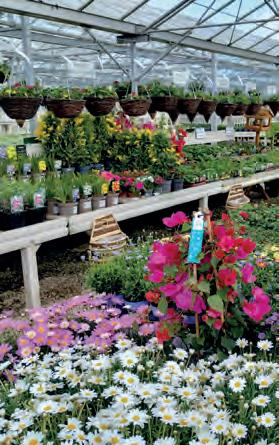





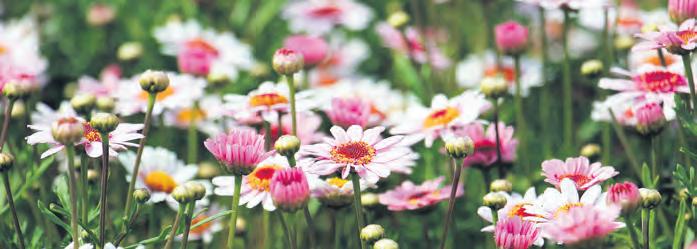














More gardeners now want to be able to plant shrubs which they know will be more tolerant of hot summers and need little attention during heatwaves
As our summers get drier and water becomes ever more precious, drought-tolerant plants are becoming increasingly important in many gardens. Even when the rain stops, these drought-tolerant plants keep going strongly. They’ll survive dry conditions while adding colour and texture to your garden.
Drought-tolerant plants, usually native to dry regions such as the Mediterranean, have evolved to thrive in dry soils with little rainfall. With climate change and extreme weather events such as drought increasingly likely in the UK, growing drought-tolerant plants means you can still have an attractive garden during a hosepipe ban.
They’re also useful for growing in a sunny border with free-draining soil and work well in low-maintenance planting schemes such as gravel gardens. They can save you time, too – for example, you can avoid a lot of backbreaking watering by using drought-tolerant plants in container displays.
Agapanthus is a fantastic drought-tolerant genus of plants, hailing from South Africa. There’s a variety of types to choose from, with both deciduous and evergreen agapanthus, with flower colours ranging from darkest purple-blue to white.

Agapanthus ‘Silver Baby’ is a compact agapanthus, reaching just 60cm in height, so is ideal for the front of the border or a pot. It has white flowers that have just a hint of blue and combines well with ornamental grasses such as Nassella tenuissima. It’s a hardy, deciduous variety.
Geums are hardy perennials that flower from May to August – and if you cut them back after flowering they should reward you with another flush later in the season. Geums look especially good when growing with contrasting colours such as blue flowers and lime green leaves. Grow in sun or part shade and they need very little watering or general care.

Something which is Ideal for borders, rock gardens and containers, this drought tolerant plant has aromatic flowers that attract butterflies and bees. Catmint blooms from early summer to autumn, with plants that expand up to three feet tall and wide and have the bonus of being adorned by butterflies and bees.


The yucca forms a stemless, evergreen rosette and features slender foliage with a broad yellow central stripe running the length of each leaf. The result is dramatic and enhanced by a tower of large white bellshaped flowers in July and August. It is good to plant on dry slopes, given full sun.
Abundant blooms make lantana a welcome addition to any sunny garden and needs little or no attention in the driest of weather. Clusters of brightly coloured blossoms adorn this plant, which grows six feet tall and wide. It’s a good choice for a container.

A spectacular plant, this tall drought tolerant flowering variety produces season-long colour in just about any landscape. Its vibrantly coloured columns range from eight to 30 inches tall. These summer to autumn bloomers are also striking when confined to containers.
This plant is derived from a cross between a Californian and a Mexican species. It is the classic evergreen for a sunny south-facing wall and known for its ability to cope with dry soil in such a difficult position. Its flamboyant yellow flowers often open from May until October.


Originally from the Californian sand dunes – so it can certainly cope with dry soil. This broad, mound-forming evergreen features neatly lobed leaves which make an attractive backdrop for the 25cm (10in) spikes of fragrant, two-tone yellow flowers. Though short-lived, this plant usually self-sows, especially in gravel, for on-going displays.
This has upright stems lined with prettily divided silvery foliage. The numerous plumes of violet-blue flowers which open from August onwards and the plant’s ability to grow in a range of dry soils without complaint explain its popularity. It’s also a good cut flower – and of course it takes drought in its stride.
Below, clockwise from top left: Agapanthus ‘Silver Baby’; Catmint Nepeta x faassenii; Geums; Yucca filamentosa ‘Colour Guard’; Fremontodendron ‘California Glory’; Lupinus arboreus
Salvia splendensHighmarket House, Banbury
Millers Grange, Witney
Sandfields, Cheltenham

Scarlet House, Stroud careuk.com/cotswolds

• Large selection of culinary and medical herbs
• Also over 30 varieties of chilli plants available

• Pesticide free, of excellent quality - and not hard on the pocket!
• We sell a large selection of herbs & various plants

• Our shop sells various sauces, chutneys, pickles, ice creams, chilli sausages and chilli burgers.

Farmcote, Near Winchcombe, GL54 5AU
Open: 15th April - 17th September.
Friday, Saturday & Sundays (also bank holidays) 10.30-5.00 and Mondays 12.00-5.00
Telephone: 01242 603860
E-Mail: janeeayrs@gmail.com
Website: www.farmcoteherbs.co.uk
Ireley Hardy Plant Nursery
A Traditional Nursery, stocking a wide range of Herbaceous Perennials & Shrubs







Open: March to November, Tuesday to Saturday, 2pm to 5pm
Other times by appointment
Broadway Road, Winchcombe, Cheltenham, Glos, GL54 5NY Tel: 01242 604160

Web: www.ireleynursery.co.uk
FREE LOCAL DELIVERIES (WITHIN A 4-MILE RADIUS) Mythe. A38 Worcester Rd, Tewkesbury GL20 6EB EMAIL: flowers@flowershedtewkesbury.co.uk


Can Hotbeds, a Victorian way of growing vegetables, make a comeback? Daniel Rose, a young allotmenteer who we featured in the spring issue of Country Gardener thinks so. Daniel is a teenager who started gardening during the first Covid lockdown and has gone on to grow vegetables on his allotment plot in Taunton. Now Dan writes about his interest in the Victorian method of growing using Hotbeds to get an earlier crop of vegetables, and it has proved to be a very successful project.
Hotbeds are an old method of getting early crops at a time when they are normally out of season, and they are most known for their use by the Victorians who used them to grow more tropical plants like pineapples and melons very successfully in the UK. This was useful because it needed no electricity or fuel and was easy to make because manure was plentiful at a time when horses were still a large part of transport.
A Hotbed is a very simple idea-but very effective. It is a layer of decomposing organic matter like manure in some sort of frame such as four pallets put together. A minimum of a foot tall of manure is advised, the effect of this decomposing releases heat. This part is capped with around six inches of growing medium such as compost to sow and plant into, the manure heats this as it decomposes. Though the capping with compost is not always done if the Hotbed is used for propagation where the seed trays or plant pots simply sit on top to be heated, this is useful to bring on small plants before planting out, which is great as it is a totally off grid way to provide heat.
If you don’t think you can get the manure, simply make a hot compost heap instead as this will release heat when decomposing as manure does; this is a good alternative for vegans.



Hotbeds can be constructed undercover in a greenhouse or polytunnel otherwise outside a cold frame, cloche or method of protection is placed in top. Hotbeds can be constructed in February and March for early sowing and planting, and later for warmth loving crops like melons. This year, in mid-February. I decided to give this method a try, as I received some free, fresh manure, so I made a Hotbed from four pallets and wrapped the inside with polythene to retain some heat. I stacked around two feet of manure, which has now sunk significantly.
I used a large amount because the earlier you construct
your Hotbed the more manure you should use. I watered the manure to make sure it would decompose properly and treaded it down to make sure the heat of the manure would last rather than being a short outburst. Next, I capped this with around six inches of compost. The heat of the decomposing manure quickly rose in the next week to around 70°C. I let this cool to around 50°C before sowing and planting.
I decided to pick some of my favourite crops to sow and plant to get some nice early harvests. I sowed two rows of carrots, two rows of beetroot, and planted two potatoes as this is a relatively small space. I placed a sheet of corrugated polycarbonate over the Hotbed to protect the plants from harsh weather. The carrots and beetroot made a quick appearance with most of them germinating, so I gave them a good thin.
The potatoes swiftly followed peeking out of the compost. Despite earthing them up slightly as they were far ahead many leaves were above ground very early in the season, but the protection of the polycarbonate and the warmth of the Hotbed meant there was no frost damage. I kept these watered well and they grew away very quickly.
The polycarbonate was kept close to the plants but not touching and this was made slightly higher each time they touched it to prevent the plants becoming leggy and to lessen the amount of air being heated. Once we were clear of any frosts, I removed the plastic as it was no longer needed, and the plants were becoming too large to be kept under it.
By this time there was still the ambient heat from the Hotbed, but the real heat had gone, although the heat wasn’t playing a huge part now, it was very important to get them going to begin with.
In late May, I decided to pull some crops to see how successful I had been and judge how mature the crops had got. I had a nice little crop of potatoes — earlier than usual, some baby carrots and some golf ball sized beetroot.

This was a success and with a couple more years of practising the use of Hotbeds, the size of the harvests will certainly increase.
The use of Hotbed is not common, and I was the only person on my allotment doing one, but I urge anyone to give it a try, as Hotbeds have great potential for gardeners, and hopefully you will be able to get some early crops too.
 The Hotbed simply made with pallets
One pallet removed showing the layers of manure and compost
Piece of polycarbonate used on top as a cloche
A good crop of healthy vegetables earlier than usual
The Hotbed simply made with pallets
One pallet removed showing the layers of manure and compost
Piece of polycarbonate used on top as a cloche
A good crop of healthy vegetables earlier than usual
From being something of an also ran in our gardens plums have in the past few seasons grown immensely in popularity providing luscious easy to grow fruit
If there was a league table for the most popular fruit being grown in our gardens this summer the position would be taken up by plums.
This delicious home-grown fruit has topped the lists of all garden centre and bursary surveys when it comes to the most in demand fruit tree.
Plums significantly make good small trees for most gardens and their delicious fruits make them even more worthwhile.

There are many different types of plum, including sweet and cooking varieties, damsons, gages, mirabelles and sloes. They have a variety of different uses, from eating freshly picked to making cakes and preserves and adding to gin. Plums can be grown as dwarf fruit trees, which remain naturally compact and are suitable for small gardens and balconies.
Plums grow best in a sunny spot in welldrained, fertile soil. Most trees in the plum family come in sizes to suit all gardens. If you choose your tree carefully you can train it into your preferred shape – as a standard or fan. Smaller trees, grown on semidwarfing rootstock are easier to maintain.
The same growing conditions apply to most trees in the plum family, although gages grow best against a warm wall to ripen the fruit.
Damsons are hardier, smaller trees that will often do well where larger varieties fail. They can be trained on walls and grown as pyramids and are also used for windbreaks or hedging.
Plums are some of the earliest fruit trees to flower. Although the trees are hardy, frosts will kill the blossom. A sheltered, sunny location will protect them to some degree, but you may need to use horticultural fleece in freezing conditions.
When the fruits have formed by June or July, it’s best to remove some so they don’t overload the tree.
Don’t prune plum trees in winter as this can cause them to develop silver leaf disease. Prune young trees in spring for shape and established trees later, to remove dead and damaged wood. Summer pruning will keep the tree manageable, and allow the fruit to ripen.
Growing plum trees is not too difficult if you give them what they need.
Plums require full sun and well-drained, sandy soil in order to thrive. They prefer a soil with a pH that ranges from 5.5 to 6.5. It is always a good idea to have your soil tested before planting any fruit tree to be sure that their pH is appropriate.

When learning how to grow a plum tree, you should know that plums can belong to one of three groups: European, Japanese, or Damson. Which group is best for you depends on your growing region and personal preference.
BLUE TIT - delicious small plums good fer eating and cooking. Reliable crops every year.
AVALON PLUM TREE - a relatively new variety with strong taste appeal and very disease resistant.
BELLE DE LOUVAIN - popular as a cooking variety and tolerates shady and windy spots, self fertile and crops in mid-August.
There are lots of jobs in the summer garden which qualify for the word essential. None however more than the pruning in June or July of wisteria.
Pruning wisteria in the summer will allow more light and air into the plant, encouraging the wood to ripen and fresh growth to develop. As wisteria is a vigorous climber, pruning at this time of year will also help to keep it under control. Wisteria flowers on old wood, meaning that the flower buds that will bloom next year form on this year’s growth. To avoid pruning out all next year’s flower buds, some pruning should be done in the summer, after flowering ends.
Summer pruning will also make the plant look much tidier and will focus flower bud formation near the main branches of the vine, promoting a stronger and more manageable plant structure.
You can do the first stage of your pruning right up until the end of summer, if the plant has finished blooming, and the cold weather has not yet set in.

When pruning wisteria in the summer, focus on cutting back the long, leafy, ‘whippy’ shoots. Do a walkaround of your wisteria and find the extending growths, count the buds up to five and then clip the remainder of the stem. remove to around five or six leaves.
Remove any dead or diseased wood as well as any weak growth, so your wisteria will have more room to grow.
Ensure major branches are not crossing over each other and remove any branches that are causing overcrowding.
Check for suckers at ground level and prune them away. Suckers look like thin branches growing out of the main trunk or limbs.
Sometimes it’s necessary to cut all the branches down to the main stem or even down to the ground to renovate the plant. This hard pruning will give your wisterias an impulse to shoot new strong branches.
Wisteria may only start blooming two or three years after a hard cut back, but the growth will be of much higher quality.
Hard pruning also allows you to re-train the plant and direct its growth vector towards a new pergola or arch.
It’s important to prune wisteria for a second time in the winter. It’s nearly impossible to get all the necessary pruning done in the summer when the leaves are on the plant.
Winter pruning ensures that, come spring, your wisteria can put all its energy into producing beautiful blooms that won’t be hidden by long, leafy shoots. There are two different species belonging to the same genus.
In terms of flowering, Japanese wisteria (Wisteria floribunda) bears elongated and narrow flower clusters (40 cm to 1.50 m in length) unlike Chinese wisteria (Wisteria sinensis) whose flower clusters are heavier, stockier (up to 40 cm in length).

The first blooms in April, the flowers develop successively from the base to the end of the cluster while the second blooms in May, the flowers all bloom at the same time on the cluster. This flowering is often repeated in summer.
Another clue, rather curious this one: the direction of winding of the tendrils. From left to right for Japanese wisteria and from right to left for Chinese wisteria.
Plums are one of the earliest fruit trees to flowerIntroducing Our Unique C.H.R.I.S. ® System.

Conservatory Insulations C.H.R.I.S ® system ensures the very best performance for your conservatory, giving you a room to use all year round, whatever the weather!



Having already installed over 30,000 systems to date, you can rest assured in the knowledge the C.H.R.I.S ® system is the very best available on the market today and is the only system specifically designed for conservatories.




The C.H.R.I.S. ® system is a cost-e ective solution which insulates your conservatory for a fraction of the cost of a new tiled roof. For complete peace of mind, we o er a 10 year insurance backed guarantee.

Our postbag this month has been dominated with readers' views about dogs in open gardens with an overwhelming majority in favour of them not being allowed.
A spokesman for the NGS told Country Gardener: "The NGS does not impose any rules about dogs being allowed in gardens which open to the public. Under our scheme some town gardens are quite small

and allowing dogs would not be appropriate. Other gardens have owners who are not happy with allowing dogs. Those who do allow them ask that dogs are kept on a short lead at all times. We understand that some members of the public like to be accompanied by their dogs and where possible we try to accommodate them but very much at the garden owners discretion. Our website details those gardens which allows dogs."
You asked readers for views about whether dogs should be allowed into public gardens. Even though I am not the doggiest person ever I would say better not, except for guide dogs. One of the pleasures of visiting gardens is to be able to sit on a lawn or smell the roses. The presence of doggy ‘poo traps would certainly diminish those pleasures.
D. Hutchins West DevonThe NGS does have to start taking a firmer line on allowing visitors to take dogs into open gardens. Last week some friends and I visited a delightful garden in south Devon. We had been looking forward to making the trip for a while and it was the most glorious day. The whole visit was spoilt by three other visitors who had their dogs with them. They were on leads and under control but barked the whole time at each other across the garden. We spoke to the owners who said they couldn’t leave the dogs in the car as it was too hot. It was a shame they said there were other dogs there as it sparked off the barking frenzy. It was just something which could be avoided.
Annie Harmer TopshamI have written several times to the NGS to get them to investigate their policy of allowing dogs other than guide dogs into open garden days. I think there is a real feeling amongst those people who enjoy these gardening openings that dogs are spoiling the experience. Some of us just are nervous anywhere near dogs big or small and whether on a lead or not it spoils the day out and many of these gardens are in confined spaces. I have heard nothing to suggest the NGS is sympathetic to this view.
I don’t think there is any need for discussion. I visit a lot of gardens open in Somerset and am I keen supporter of the NGS and love these gardens but over the past two years perhaps since Covid there are just too many dogs. It isn’t a cleanliness issue but the gardens I have been to have had dogs barking, pulling on leads, trying to reach other visitors and generally making it less of a peaceful, happy experience which a garden visit should be.
Anna Graham MineheadLast year I found growing outdoor tomatoes to be surprisingly like those grown in the greenhouse so this summer I’m switching things around and growing more out of doors. I like the idea of the fruits developing in the sunshine and fresh air. It also means I don’t have to worry about greenhouse pests such as whitefly and don’t have to worry about those scorching days when the greenhouse becomes a furnace.
I suppose the downside it that wind, rain, fungal spores make the plants more prone to wind and fungal damage and being indoors will I suppose make them ripen quickly. There’s thing very Mediterranean about ripening tomatoes out of doors so that’s where my hopes are lying this summer.
 Andy Preston Newton Abbot
Andy Preston Newton Abbot
I have actually arrived at a garden, seen dogs being allowed and particularly in some of the smaller gardens decided not to bother to go in. Lost income for the NGS!
Kay Frillingham NewquayI am well into my 70’s and my cocker spaniel Amy goes everywhere with me. She is well behaved, friendly, quiet and toiled trained. Why shouldn’t I have the freedom of walking around a lovely garden with my dog? We both love it. Young children – that’s another matter!
Donna Greene YeovilMy father always used to buy several jars of Epsom salts which he copiously added to trees, bushes and vines throughout his Devon garden. He claimed it boosted the chlorophyll inside the plant which in turn he claimed gave the plant more energy. He used to take the Epsom salts down to the allotments and share it out with his mates. More energy meant the fruit produced more sugar and the more sugar the sweeter the fruit. I never chose to argue with him and I don’t think anyone ever did.
Cathy Overton Liss
I challenged a large plant nursery near us about the use of chemicals in almost everything they grow. They don’t make a secret of it but rather market the fact that their plants are disease free. The response I got was that while organic gardening works in smaller, private gardens it isn’t an option for larger nurseries simply because there aren’t enough alternatives to pesticides for growing in real scale. The hope is that longer term chemicals can be replaced with bio stimulants and biological pesticides and that better products are always being researched and made available. The nursery owner told me his motivation was to provide a saleable plant with a proper shelf life. It seems now that what we are buying from garden centres and larger nurseries is likely to be grown with the use of chemicals which doesn’t suit us all but seems for the time sadly inevitable.
I wonder if your readers have had a bumper wisteria season like we have enjoyed. We followed all the rules about pruning last year and it seems to have worked. We have been blessed with huge flowers and many more of them covering the plant. So doing things properly does seem to pay off in the garden.
Nicky Walsh DawlishI would urge readers who enjoy growing their own herbs to grow more oregano. It is probably the one herb where the difference between homegrown and bought in is most noticeable. The homegrown variety is full of spicy, peppery flavour. Planted in full sun it roars away and produces lovely mauve flowers. It is just one of those things in the garden, which is a real pleasure to grow.
Mollie Rankin Summerton

If you’ve been spending much time in the garden recently you will be aware of what hard work it has been. Really hot weather making things even more difficult and demanding. So gardeners need all the help they can get during summer weeks when everything is still growing at a pace and needs tending There’s not enough time to do everything which is needed. So, it’s important to get some help. There are so many products lined up now to

Now the growing season is in full swing it’s very difficult to keep up with fast growing shrubs and climbers which need to be kept under control. One great idea is using Rivelin Glen Products which are well designed wire anchors. They are quick and easy to attach to concrete posts (without drilling) to act as an ‘eye’ by threading wire through them to create a trellis system. The Gripple Trellising System is ideal to use with these Wire Anchors as the wire does not stretch, takes up to 100kg load and has a life span of 15 years. You can achieve multiple rows with one length of wire and two tensioners so it’s no more sore hands or sagging wires. Rivelin Glen Products are the main stockists of the Gripple Trellising System. Wire Anchors cost from £10 for a pack of three. Gripple starter pack £19.75p
Email info@rivelinglenproducts.co.uk or call 01246 462666 www.rivelinglenproducts.com










take off the hard physical work in the garden that most of us would be crazy not to seek help. And then there’s the opportunity of when shopping around to treat ourselves to a little luxury so when it comes to gardening it is not all hard work and no pleasure. At Country Gardener we are always on the look out for great products and fresh ideas so here’s a few to help take the strain.

‘QR’ (Quick Return) compost activator has been helping gardeners make compost and improve the health of their soils since the early 1930’s. Invented by Maye Bruce, one of the founder members of the Soil Association, ‘QR’ became popular all over the world until the 1970’s. Made from a blend of dried herbs, ‘QR’ speeds up the decomposition of organic matter. There is no turning required and compost can be made in as little as 4 weeks. It is suitable for use with garden or kitchen waste in all types of compost bins.

‘QR’ is easy to use – simply add water to the powder and apply to the layers of the heap during its construction.


Available from Exedra Nursery, Stroud Tel: 07487 537026 and online at Gardener’s Cottage Plants www.gcplants.co.uk or Tel: 01830 806813





We
























































British manufacturer SCH Supplies has its peak demand from gardeners and smallholders during the spring and summer, as gardeners and smallholders up and down the country are eager to purchase equipment to help with tasks around the grounds. The Professional Power Sprayer (PS22) is a versatile sprayer for easy application of herbicides and fertilisers to large and small areas. The tank is mounted on a robust tray chassis, with two leading wheels that provide stability and a rear castor wheel that acts as a line marker.
The sprayer is fitted with an adjustable height boom, and when positioned low to the ground, drift is minimised; therefore, close-edge work can be carried out. The boom also has a ‘break back` function, which allows it to fold if it meets a tree or fence, preventing damage. Its four nozzles have a maximum spray width of 2400mm (96”), and the two outer nozzles of the boom can be turned off to give a narrow spray width of 915mm (48”) if required. This also allows the sprayer to be easily transported in a van or a large boot. The 12-volt diaphragm pump produces a flow rate of up to seven litres per minute. A pressure gauge is included, and the flow rate is adjustable. The pump is powered by its own integral battery, and the average spray time per battery charge is approximately 5 hours of normal spray use. With tank refilling and on/off time, a longer working duration is to be expected. The Professional Power Sprayer is available in other sizes and has optional extras to choose from.
SCH manufactures over 200 quality British-built machines. For a free 80 page brochure featuring all the designs and variations, contact SCH on 01473 328272, email sales@schsupplies.co.uk, or visit their website to find out more www.schsupplies.co.uk
Make the most of your garden this summer and relax in style. This stunning five seater Lima Rattan Sofa Lounge Set allows you to create the perfect relaxation seating area, outdoors. This set consists of a three seater sofa, two armchairs and a square adaptable stool and includes removable cushion covers for easy cleaning. Made using durable polyrattan making it virtually maintenancefree allowing you to enjoy your garden set without any worries. This set is available at an incredible 70% off and is sure to sell out so grab it while you can. Was £2,259 now £679 ONLY when you visit outandout. com. Delivery excluded. While stocks last.

Enjoy your garden throughout the year, whatever the weather with a stylish Eden Veranda and now available with a superb finance deal – buy now, pay later plus you can save up to 25per-cent off* in a Summer Sale. Constructed from the highest quality materials and bespoke manufactured, an Eden Veranda is a stunning addition to any home. With accessories such as intelligent heating and lighting you can spend more time ‘outdoors’ in comfort. Every Eden Veranda is powder coated with a hard-wearing weather-proof finish, available in a choice of 56 colours and installed by engineers.
To benefit from these offers visit edenverandas.co.uk or call 0800 107 2727 and use code CG240623 *Terms & Conditions apply, see website for details.

Annie Morris from near Wellington in Somerset only discovered gardening during the pandemic but she’s now a passionate organic gardener who is keen to share her two recipes to fight off pests
I don’t think my story is unusual but I should admit up front that I am a ‘Covid lockdown ‘gardener who in the past three years has found enormous pleasure in being out in my garden and learning about plants and growing vegetables.
I have a small garden just outside of Wellington in Somerset and in March and April three years ago I started to invest time and energy into growing plants and vegetables. I built some raised beds for vegetables and cleared out a flower border. I read and read about gardening and often fell asleep in the evenings over a gardening book or magazine.
I discovered your magazine and love it.
There’s so much I could write about, but my friend urged me to write to you to explain how I fell into organic gardening and how garlic and chillies are my secret defences against pests.
What I learned very quickly as a novice gardener is that a few minutes in your kitchen at the chopping board and you can extract these plant-made defences to make an organic spray which won’t damage the environment and costs practically nothing. Two home-made deterrents which are cheap to make, wonderfully effective and non-chemical are garlic and chilli sprays.
Organic gardeners look to nature for ways to stop and prevent pest infestations. Luckily, nature complies and garlic is one powerful cure.
The active sulphur compounds in garlic not only act as a powerful pesticide but also eliminate fungus and deter grazing vermin. Best of all, you’ll be able to free your plants of pests without leaving behind harmful chemicals or residues.
A homemade garlic spray has many uses and can be applied to vegetable, fruit, ornamental, and indoor plants.
When used as a foliage spray, garlic is effective against aphids, Colorado potato beetles, whiteflies, bean beetles, cabbage worms, spider mites, moths (including the diamondback moth), ants, and termites. If used as a soil treatment, garlic water is a recognized treatment for nematodes and fungus gnats.
The active sulphur compounds will stop a variety of fungal and mildew infestations. It is a very effective treatment and preventative measure for powdery mildew.


Process the head of garlic in a blender. Then add two cups of water to the blender and pulse a couple of times.
Pour the mixture into a glass container and let it sit for one day.
Strain off all the solids and dilute with enough water to get a total of one gallon of solution. Use a spray bottle to soak the tops and bottoms of each leaf in the infested area once every week until the problem ceases. Soak the infected soil thoroughly once a week to get rid of fungus gnats and nematodes.
Chilli spray can reduce populations of aphids, spider mites and whitefly, not by killing adults buy by coating eggs with an oily mix that prevents them from hatching. Homemade chilli powder sprays can protect plants against insects and other pests that may be eating the garden. Chilli powder spray won’t kill all insects, but the spray will repel most insects and other pests that eat garden plants. It should not be sprayed directly on fruits, vegetables or herbs meant for the table as they could end up tasting like chilli powder. Limit the spray to nonedible leaves. For a basic chilli pepper spray, add one and a half teaspoons of chilli powder to one quart of water. Add two drops of liquid dish soap to help the spray adhere to surfaces. Like human skin, some plants can be irritated or burned by chilli powder sprays, so always spray one or two leaves as a test. Leave the spray on the test leaves for several days to watch for a reaction. If the sprayed leaves are wilted, yellow or look burned, do not spray the plant.
Many of us like to lead active lives, but that can become increasingly difficult if we begin to experience skeletal and muscular issues. A growing number of people are discovering that a product called Turmeric+ Gold can help keep them active and living the life they love.
Jacqui Hunter, 60, who lives in Northamptonshire, is one of those people. She runs her own event management consultancy for the medical and pharmaceutical industries, as well as enjoying a busy life which includes, golf, yoga, gardening and travel.

‘I used to suffer with great discomfort in my knees and neck, particularly when going up and down the stairs.’ she remembers.
‘I read about the benefits of turmeric around three years ago. I’ve spent lots of time in Goa where it’s often used, so I was intrigued to learn more.
‘Having a background in the pharmaceutical industry I research products thoroughly. I really liked all the science and studies behind Turmeric+ Gold.’ Turmeric contains compounds called curcuminoids, the most notable of which is curcumin. Not only is curcumin responsible for turmeric’s distinctive yellow colour but it’s also what makes it such a powerful spice.
However curcumin is difficult for the body to absorb so the scientists at FutureYou Cambridge used a patented Curcuma Phospholipid Complex formulation to make Turmeric+ Gold 30 times more absorbable than standard turmeric.
Just pay £1.50 postage
FutureYou Cambridge is offering you the chance to try its premium joint health product, Turmeric+ Gold, for just the cost of the £1.50 postage.*

The latest addition to their bones and joints range is based on the same formulation as their bestselling product Turmeric+.
The products were formulated by FutureYou Cambridge, wellknown for its science-backed health supplements. The company, based in Cambridge, regularly consults with highlyregarded scientific and nutritional experts and has also developed close ties with world-leading educational institutions.
Turmeric+ Gold is the most advanced and purest turmeric formulation yet, providing the same 100mg of curcumin as it’s counterpart but delivering it using sunfl ower lecithin which makes it allergen-free. It also comes in an easy to swallow capsule rather than a tablet.
Both versions contain the patented Curcuma Phospholipid Complex which makes them 30 times more absorbable than standard turmeric.
They also contain vitamin C which contributes to normal collagen formation for the normal function of cartilage and vitamin D, which contributes to the
They also added vitamin C, which contributes to normal collagen formation for the normal function of cartilage and vitamin D, which contributes to the maintenance of normal bones and maintenance of normal muscle function.
maintenance of normal bones and maintenance of normal muscle function.
‘I can’t think of a better way to convince people. If they like it, they will stick with it. Tens of thousands of customers already do.’ says Adam Cleevely, Chair FutureYou Cambridge.
“I really liked all the science and studies behind Turmeric+ Gold.”
If you have any gardening problems you need help and advice with then contact us at Country Gardener either via email at editorial@countrygardener.co.uk or by post to Mount House, Halse, Taunton, Somerset TA4 3AD.
Can you add paper or cardboard which has coloured print on it into your compost bin?
Alan Strachan MartockSurprisingly glossy, printed and office papers are all fine to compost. They might take a little longer or add fewer nutrients back into the environment. The concern has always been that the print contains toxic heavy materials, but one study showed that printed paper had less toxic materials than straw or grass.




I cut back summer and autumn raspberries in early spring which is clearly a mistake. What should I have done?
Your autumn fruiting raspberries will grow, flower and fruit at the top of the stem as they should. The summer fruiting raspberries will also produce new fruit canes but no fruit as they crop on sideshoots on the previous year’s canes. In summer after you have picked the last of your summer raspberries cut those canes off at the base.
How can I get longer white stems on my leeks?
Brian PotterCirencester
When the plants are about as thick as a pencil and 20 cm (8 in) high, they will be ready for transplanting to their permanent position.
Lower the young leeks gently into the holes and fill the holes with water. The water will wash enough soil over the base of the plant to allow it to become established. As you hoe the ground from time to time the holes will gradually fill up with soil.

Blanching leeks increases the proportion of plant which is edible and improves the flavour which would otherwise be strong and harsh. Start blanching in mid-August, this is a gradual process and should be done in several stages rather than all at once. As the plants increase in height you can earth them up which will blanch the stems. Scoop soil up around the plant which excludes the light from the bottom part of the stem and tuns them white. Don’t earth them up so high or soil will become lodged in the leaves of the leek. You can earth them up twice during the growing season.
Is there any hope for a row of brown, unhealthy upright conifers which are up against an unsightly wall. We have tried to look after them so carefully. But for the past two years they have been fading and now look dead.
The soil could be very dry, and this will be exaggerated if the conifers are up against a wall and have little soil to expand into. A lack of moisture causes severe foliage browning and poor health. Last year’s very hot weather would have made this worse again as they are up against a wall which would have reflected the heat. So, the conditions you are asking these conifers to thrive in is not ideal. Try watering well and mulching and be patient. Conifers are resilient and it make take a year or two but look out for fresh green growth as a sign they are on their way to recovering.
I’d like to try something different in my new garden and like the idea of growing peaches. It sounds like a bit of a challenge –is that right?
Lots of gardeners now successfully grow peaches - the high proportion in a greenhouse but not exclusively so.
Peach trees are best planted against a southor south-west-facing wall or fence, where they can be trained as a fan, soaking up the heat and getting as much sun as possible to ripen the fruit. They will only fruit successfully as free-standing trees in the warmest, most favourable locations.

There are naturally compact varieties for growing in containers too. In fact, there is
a long history of growing peaches in the UK – you’ll often find glass ‘peach houses’ in the walled kitchen gardens of stately homes, where peach trees were fantrained against the back wall to provide ‘exotic’ fruit before the era of refrigerated transportation.
Today, peaches can be grown outdoors as well as in a greenhouse, and in even the smallest of gardens
Bare-root trees are only available while dormant, from late autumn to early spring, for immediate planting. Potted peach trees are available all year round.
Most commercially available peach trees are grafted onto a rootstock called ‘St Julian A’, which limits their size, making them suitable for even small gardens. There are also dwarf varieties bred specifically for container growing and often sold as ‘patio peaches’, reaching only about one and a half metres (five ft) tall and needing little pruning.
I always plant my cabbages quite deep, certainly up to the first leaf but they always seem to grow very leggy. They are not short of light so I am not sure what the problem is.
The most common causes of stretching in brassicas is poor light especially at the seedling stage but also at any stage afterwards. The other issue is almost certainly an excess of nitrogen perhaps from too much manure or using nitrogen rich fertilisers. Firm soil is also important for most brassicas for tight head formation and balanced growth. You certainly should be able to control the early stages of growth a lot better.
I have a Cox’s apple tree which should produce an abundance of fruit every year but has suffered from what I am sure is brown rot. I have tried spraying with fruit tree wash and thinning the apples to one per branch, but nothing seems to work.

Brown rot is normally a secondary infestation meaning something else is damaging the tree already. The usual suspects might include codling moth. The treatment for this is grease bands put in place in September and winter wash several times to kill off overwintering eggs. Also make sure the tree is pruned well and is open to the air. Good hygiene is always key to trees which start to have health problems.
Why are our strawberries tasteless? They look perfectly OK but just have no flavour which is very disappointing as I put lot of effort into growing them.
Brian
This is a more common problem than many think. There are also plenty of reasons for it. Poor soil conditions, low sun levels, and planting at the wrong time can all lead to sour or bitter harvests. Overcrowding and unpruned plants can also produce poor crop yields. You need to grow strawberries where they can get eight hours of sunshine a day. Don’t overcrowd them and mulch them with straw to keep the roots damp. Also generally, you shouldn’t allow strawberry plants to set fruit within the first year. Pick off blooms as they appear to force more energy into producing stronger daughter plants.

I seem to have a lot of wood shavings around the place. Can I use them as seed compost?
Di
 Barber Chiddingfold
Barber Chiddingfold
There are two problems. Firstly, the chances are they would be too coarse for seed compost the other problem is that raw wood waste may contain bacteria and fungi which will harm the compost and the tender seedlings. You can however safely add the wood shavings to the compost bin.

Our bulbs didn’t do well this year and when I dug them up lots of them were rotten or covered with mould and had to be thrown away.
Katie HallExeter
Bulbs need well drained soil so it maybe the soil doesn’t drain and gets clogged up. Dampened bulbs are certainly prone to all sorts of problems and in the worst cases will rot.

I would like to start some no dig beds on some rough soil for winter vegetables. I can plant in summer. If I lay some cardboard down in the beds will the plants roots be able to grow through it?
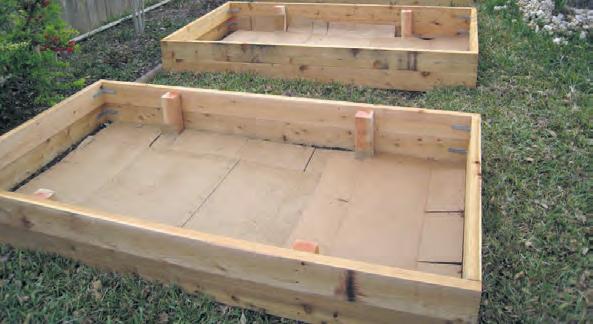 Steven Johnson Lyme Regis
Steven Johnson Lyme Regis
Cardboard is now used a lot when it comes to starting new areas for growing vegetables. Cardboard is thick enough to kill weeds and to prevent all but the strongest perennial weeds from breaking through. However, it is also very biodegradable so that by the time the deeper rooted crops hit the level of carboard is should have decomposed and at least be soft enough to allow roots to penetrate to the soil below.
If there are white tufty fungus on the bulbs, then the problem is scierotinia disease which produces tiny black structures that persist in the soil and can do long-term damage. These need wet conditions to grow so again drainage might be the issue. Remove all the infested bulbs and add some grit into the soil, Plants with hollow stems such as dahlias and sunflowers tend to be more vulnerable to rotting.
Our banana plant is more than ten years old. We often get flowers and tiny bananas but over the last two years there has been no flowering. Is this just age?
Rebecca Davies SouthamptonThe answer may be that the plant is pot bound and needs moving to a much bigger container. When you are moving be careful to tease out the roots and put the same compost/soil mixture into the pot. It might be worth putting the whole container on ‘feet’ so that when you water any surplus drains away.











There comes a point when even the most hard working and diligent gardener needs a break.
The hectic days of sowing and planting in May and even June are now past us and the garden should be growing to some sort of order. So it’s a bit of a tradition that there’s now the time and the opportunity for gardeners to down spades and secateurs and start to enjoy days out visiting gardens , plant fairs , shows and other events.
Certainly July and the start of high summer sees lots of places to visit and lots of gardening experiences to enjoy.
At CountryGardener we have put together just a few ideas for you.

The popular programme of Rare Plant Fairs continues during July, with more events held in interesting and unique gardens with their own individual style, making a visit to one (or more!) a great day out for all gardeners. A selection of specialist nurseries attends each of the fairs, all experts in the plants that they grow. The full programme is:
WINTERBOURNE HOUSE AND GARDEN, Birmingham, Sunday July 9th, 10:30am to 5pm. Winterbourne is one of the best surviving examples of an Edwardian Arts and Crafts suburban villa garden. The botanical garden contains plants from around the globe with collections of plants from China, North and South America and Alpine areas of the world.
HIGHNAM COURT, near Gloucester, Sunday July 23rd, 11am to 4pm. These stunning gardens have been totally and lovingly restored to their former glory, with many new additions being made to complement and enhance the original design, during the last 25 years and more by owner Roger Head. The fair supports the work of important local charity Cobalt Health.
Visit www.rareplantfair.co.uk for full details, including admission charges and a list of the exhibitors attending each one.
Downstream Dorset, River Tales and Local History provides a colourful and truly inspiring exploration of Dorset with its many rivers and riverside towns and villages.
It also delves into lesser-known tales and gems of Dorset rich history!
Mary van Coller spent years travelling the county to explore riverside communities and their history before being published by Spiral Publishing Ltd and Country Books.
20 per cent of all proceeds is donated to the Dorset and Somerset Air Ambulance.
The book is a colourful, easy-to-read journey of exploration and discovery along the many rivers and streams flowing through the beautiful county of Dorset.
For ease of navigation the author has divided the book into sections – North Dorset, West Dorset, The Isle of Purbeck, Poole Harbour and East Dorset. Each chapter is devoted to one of the rivers, tributaries or streams that have brought life to the countryside and to the people who live there.
Starting at the source of the river the author follows the waterway to its mouth, showing the derivation of place names along its course and writing fascinating snippets about people and events both past and present.
The author has added a personal touch by including her husband, Ryan, in anecdotes about their trips around Dorset. Together they have walked the hills and travelled the byways looking for springs and mouths of rivers.
It’s just £19.95 +p&p from www.DownstreamDorset.co.uk or www.countrybooks.biz
ISBN 978-1739582401 20 per cent of all proceeds donated to the Dorset and Somerset Air Ambulance.
High summer and colour will be everywhere to see - from the fiery scarlet tones of Rosa moyesii to the subtle hues of soft pink Phloxes and the creamy frothy flowers of Astrantia at Marwood Hill Gardens.
The award-winning National Collection of Astilbes are well under way, with a crescendo of gaudy pinks and reds to the muted tones of silver and white forms. Planted by the lakes and streams all basking in the warm sunshine.

Stately bushes of Cornus kousa grace the borders with their display of creamy-white bract like flowers while others turn rosy pink.
A cheerful time of year with long days to soak up the enormous number of plants in flower. A great time for a cream tea at the tearooms and lots to buy at the fascinating plant sales.
Marwood Hill Gardens, Nr Guineaford, Barnstaple, North Devon EX31 4EA Tel: 01271 342 528

www.marwoodhillgarden.co.uk
Email: info@marwoodhillgarden.co.uk

Boscrege Caravan and Touring park in Cornwall is a peaceful and picturesque park, set at the foot of Tregonning Hill, Godolphin National Trust and amongst tranquil Cornish lanes in an area of outstanding natural beauty. The park, open all year is close to the l Cornwall coast and a few minutes’ drive to Praa Sands, one of Britain’s nicest beaches. So, if you are looking to take a luxury holiday (doggie friendly with dog friendly homes and on-site designated fields for the dogs too) in Cornwall in a either a self-catering caravan, lodges touring or even purchasing your very own holiday home then contact Boscrege Caravan and Touring Park.
Boscrege Caravan Park, Boscrege, Ashton, Cornwall
TR13 9TG Tel: 01736 762231
www.caravanparkcornwall.com

Home to four National Plant Heritage collections, this private valley garden spans over 20-acres and showcases three stunning lakes, rare trees & shrubs, and colourful surprises throughout each season. Not only a haven for wildlife, the garden is also the perfect environment to explore and be inspired. Enjoy a day of inspirational and relaxation for the whole family.
Catch up over coffee and homemade cake or a cream tea in the picturesque Garden Tea Room or take a bit of Marwood magic home with you from our Walled Garden Nursery and Plant Sales.
Visit our family home with its beautiful Walled and Woodland gardens, Fernery and Bog garden, walks to the Atlantic Coast, fascinating architecture, collections, displays and film exhibition.
Location for Enid Blyton’s ‘Malory Towers’.
* Dogs welcome * Holiday Cottages *
* Homemade light lunches & cream teas * * Hartland Quay 1 mile * House, Gardens, Exhibitions etc and Café until 3rd October
Sunday to Thursday 11am - 5pm (House 2pm - 5pm last adm. 4pm)
NB: Main reception rooms only will be closed for filming 12th – 29th June
For more information and theatre events see www.hartlandabbey.com Hartland, Nr. Bideford EX39 6DT 01237441496/234

We offer special all counties prices when advertising with our features, plus 100 words of free editorial with an advert. Speak to one of our sales people for more details.
Explore 14 acres of RHS partner gardens, moat and medieval Palace in the heart of historic Wells, Somerset

Group visits welcome with Tour Packages available (including Senior Gardener's Tours)


ADMISSION: 12 months of return visits on any normal sightseeing day or special Groups rates available
Plan your visit at: www.bishopspalace.org.uk

DOWNSTREAM

RIVER TALES AND LOCAL HISTORY BY MARY
VAN COLLER
Your perfect travelling companion for exploring the rivers and riverside towns and villages of beautiful Dorset. Just £19.95 plus p&p. Order from www.downstreamdorset.co.uk or www.countrybooks.biz

20% of proceeds to DORSET AND SOMERSET AIR AMBULANCE

26

CARAVAN
BOSCREGE CARAVAN & TOURING PARK

THE MOST PICTURESQUE CARAVAN PARK IN CORNWALL
With a welcoming atmosphere and set in 12 acres of Cornish countryside only two miles from the beautiful sandy beaches of Praa Sands, Boscrege Caravan & Touring Park is the best place to enjoy your Cornish holiday.
Each of our luxury holiday homes comes with a private garden and Wi-Fi. Perfect
01736 762231
GARDENS & TEAROOM

for families and couples, we are open all year, and offer seasonal pitches.
We offer the following:

• Designated dog walking fields
• Pet friendly accommodation

• Comprehensive storage
• Luxury holiday homes for sale
Open every Friday 2pm - 5.30pm from 5th May to 29th September
Also last weekend in May & August Bank Holiday weekend - Sat, Sun & Mon

GARDENS: adult £5, child £1

CADHAY, OTTERY ST. MARY, DEVON, EX11 1QT 01404 813511 www.cadhay.org.uk Member of Historic Houses
Honiton Agricultural Show

Acts Booked So Far... Devil's Horsemen - Cossack
Trick Riding, Jamie Squibb Freestyle Motocycle Stunt Show, Animated Magical Moments, Twistopher Punch & Judy, Professor Crump. Livestock, Horses, Vintage Tractors & Classic Cars. Over 400 Trade Stands. Fabulous food and entertainment.
ADVANCE TICKETS JUST £17.50 (ACCOMPANIED UNDER 16 GO FREE) AVAILABLE FROM www.honitonshow.co.uk

Secretary: Marcelle Connor, Bank House, 66a High Street, Honiton, Devon, EX14 1PS info@honitonshow.co.uk

We produce and grow the largest selection available in the UK. Plants are pot grown and suitable for garden, patio or bonsai.
Visitors welcome Mon-Sat 9am-1pm & 2pm-4pm
Barthelemy & Co (DCG), 262 Wimborne Rd West, Stapehill, Wimborne, Dorset BH21 2DZ Tel: 01202 874283 enquiries@barthelemymaples.co.uk




July is an excellent month for the magnificent collection of cottage plants at Cadhay Gardens in the exuberant borders leading down to the medieval fishponds where the water lilies are now firmly established.

Dahlias are left in the ground over winter and there was a concern that they might have taken a bashing with the heavy frosts but they have survived and have been supplemented as an insurance policy so the collection will be as good as ever with a multitude of colour. The allotment holders have been busy in their plots and the fruits of their labour will be very much on display.
The gardens are open from 2pm to 5pm every Friday afternoon. More details can be found on cadhay.org.uk
Cadhay Gardens Cadhay, Ottery Saint Mary EX11 1QT
The whole of July is taken over in admiration of sweet peas at the popular Forde Abbey gardens on the Somerset and Dorset border. From 10.30 am on Saturday, 1st July through to Monday 31st July it is very much a case of a summer of sweet peas with arrays of the popular flowers throughout the gardens and bunches available at the Gift Shop.
Music and theatre also find a place in the summer gardens. On Friday, 28th July at 7.30pm there’s a Wild arts Opera Evening, an open air performance with an evening featuring some of the greatest stories of all time, with dramatic intrigue, jealousy, comedy, idealism, and pure love.
Tuesday 1st August sees a performance of The Merry Wives of Windsor by the Folksy Theatre from 7pm.
Forde Abbey, Chard, Somerset TA20 4LU
The Honiton Agricultural Show is planning for a great celebration of rural life in the East Devon countryside on Thursday, 3rd August. The show has a fabulous array of entertainment and welcomes the Devil’s Horsemen performing displays with some of the world’s best known horses from film and television appearances. Squibb Freestyle Motocross Arena Stunt Show returns with daredevil jumps and stunts.
There will be children’s entertainment and the chance to meet the animated characters Sheridan the Sheepdog and Pumpkin the Pony and the Twistopher Punch & Judy Show.
At the heart of the show are the livestock and horses including the majestic heavy horses, private driving and a variety of sheep breeds and dairy and beef cattle. With an array of shopping on offer, food and drink there is something for all the family.
For further details or information on becoming a member of the association contact 01404 41794, or on twitter @honitonshow1890. Gates open at 8am until 6pm. Discounted Early Bird tickets are available at £17.50 in advance (ticket prices held from 2022) and two accompanied children (Under 16) are free. Honiton Showground, Stockers Farm, Gittisham, Devon, EX14 3AW www.honitonshow.co.uk
The Bishop’s Palace in n the heart of the city of Wells are preparing for another busy couple of months with a variety of activities from festival theatre and opera to more traditional workshops and gardening events.
The highlights include some events in the Wells Theatre Festival form Thursday 6th to Sunday 9th July. Details at www. bishopspalace.org.uk/event/wells-theatre-festival. Cut flower enthusiasts can join Jo Stevenson in a beginners guide to growing cut flowers on Saturday, 8th July from 9am to 12.30 at a cost of £40. The 14 acres of tranquil gardens in the heart of medieval Wells will be hosting a series of spring and summer events for the family. The focus of course remains the stunning, gardens in the heart of Wells.
You can wander along and around the many herbaceous borders, savour the scent of roses in the parterre, admire the beautiful views of the gardens, moat and further afield from the top of the ramparts.
Over the years the gardens have changed as successive bishops have added their legacy and today these gardens have Grade II listed garden status due to their historic nature.
Entry is free most Fridays to RHS members with starred cards. This offer is not valid on certain event days so please check the website for details .

Bishops Palace Gardens, Wells, BA5 2PD www.bishopspalace.org.uk
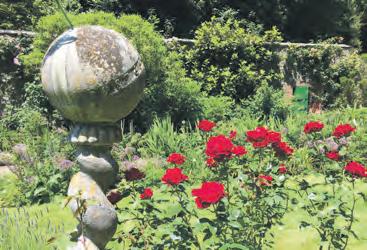
With summer in full swing there are hundreds of gorgeous gardens opening their gates for the National Garden Scheme this month. From stately acres and country gardens to community spaces and city places there is a garden to explore and inspire near you. With most open gardens selling tea and cake, a garden visit makes a perfect, affordable day out. Find a garden near you: ngs.org.uk
Much awaited outdoor theatre returns to Hartland Abbey later than normal this year - at the end of July. Thanks to The Plough Arts Centre, Torrington, A Midsummer Night’s Dream, Shakespeare’s wonderful comedy, will be performed by Box Tree Productions to start the summer season of a variety of performances for all ages.
It is a great way to spend a relaxing evening after a day enjoying the house and gardens and perhaps taking in the beautiful coastal scenery of the Hartland Abbey estate. Younger visitors can enjoy finding where around the house and gardens they saw their heroes in the latest Series 4 of Enid Blyton’s Malory Towers released on iPlayer in June. Hartland Abbey IS Malory Towers!
For all information www.hartlandabbey.com or Tel: 01237441496
Hartland Abbey, Hartland EX39 6DT
Barthelemy & Co near Wimborne in Dorset was established by a French nurseryman almost a century ago and the Skinner family now specialise in propagating and growing acer palmatum – or Japanese maples as they’re known.
Throughout spring, summer and autumn the delicate foliage of the acer presents exquisite shadings of Mother Nature’s gold, pink, purple, green, yellow, orange and red. Acers are a delightful addition to anyone’s garden, giving an aura of peace and tranquillity. The ten-acre nursery at Stapehill has a huge collection of Japanese maples to choose from and expert staff are on hand to help select the right variety and to offer advice. Over 100,000 acers are produced at Barthelemy and Co every year approximately 15,000 - 20,000 of them are grafted named palmatum varieties, as one of the largest specialist growers of their kind.
Tel: 01202 874283
www.barthelemymaples.co.uk

Looking out from her newly opened barn, there can hardly be a more idyllic setting than Amelia’s Flower Farm in the Combeinteignhead valley, bordering the River Teign in South Devon.
Looking to the left there are views of the winding Teign Estuary, and to the right sheep graze on the steep rolling hills. In the middle is the two-acre flower farm where Amelia CooperSmith and her husband Giles grow thousands of heirloom, scented and unusual varieties of flowers for their customers.
A former primary school teacher, Amelia’s flower business grew from her love of growing flowers in her garden while raising her three sons. She explained: “Escaping into the garden was my relaxing time. I grew lots of flowers and started to share bouquets with friends who asked for more. I taught myself and the business snow-balled from there.

“I also realised that there were flowers that I thought were run of the mill but other people knew nothing about and I loved to share that knowledge.”
But it was the summer lockdown of 2020 that proved to be the real turning point for her business.
“We had been walking past this field daily for ten years and then it came up for sale which is rare for land around here. So we went to auction and scarily ended up buying it. I jokingly said I could turn part of it into a small flower patch, then lock down happened and we spent the whole summer up here.
“My husband was in construction and his work stopped. He suggested that we plant the whole two acres - I thought it was ridiculous and would be completely unmanageable but three years later here we are.”
Three years on from growing flowers in her garden the land is planted with hundreds of varieties of flowers, herbs and shrubs and the couple both work full time on the business. They have planted and built their six polytunnels around the ancient orchard

trees, focusing on providing a favourable environment for wildlife and the land. They are strictly chemical-free, no-dig and make their own compost.
“We plant a mix of annual, perennials and shrubs. We are gradually moving more into perennials than annuals. They’re better for the soil, less labour for us and you get a more interesting flower like the aquilegias which are a bit more unusual and people love”.
One of Amelia’s key focuses is not just to grow flowers that are different to those sold in supermarkets, but that also fit in with her garden-gathered and country-style aesthetic: “You would not be able to order the types of flowers that suit this look from the markets in Holland.
“A lot of florists are starting to come round to buying flowers that are local and seasonal and increasingly people want to know more about where they come from. Lots of supermarket flowers come from Africa, spend eight weeks on a boat to get to the markets in Holland and don’t have any scent.
“I’m fine with that but I want to offer people a choice of heirloom and unusual varieties of seasonal flowers that aren’t available in supermarkets and that have an amazing scent.”
Wedding flowers are a significant part of the business, and this partly guides Amelia’s choice of planting: “One of my favourite things is to decide what we’re going to growwhat colours are really popular and what the wedding themes are. For a few years it’s been dusky pinks, blush pinks, coffee colours - all those antique colours have been really popular.
“I always have to look for trends a few years ahead - there’s no point in growing lots of bright yellow or bright purple because they won’t get used in wedding flowers. I might use them in other bouquets but overall we grow more pastels than strong colours.”
“I love educating people about the seasons and introducing them to amazing alternatives. Often when a bride-to-be comes to me to talk about her wedding flowers it
How a former Devon primary school teacher found a new direction and now heads up a flourishing business growing and selling thousands of heirloom varieties of flowers
‘I love to teach people how to growwhat to grow, the difference between hardy annuals, perennials, when to sow them, and teaching them about the seasons’'Escaping to the garden was my relaxing time'
is her first foray into flowers so it's a learning process about what’s in season - if they are having an October wedding we have to have the conversation about why they can’t have peonies.”
Local deliveries around Devon proved too time-consuming so they switched their focus to nationwide delivery - now sending flowers via Royal Mail all over the country - making sure these deliveries are low impact in terms of the environment: “We don’t use any single-use plastics or oasis in our floristy. We tie our bouquets with twine, package them in brown paper and our cardboard boxes are tied down with rafia.”
From May to September Amelia runs Pick Your Own sessions at the farm on Saturday mornings - locals can wander round the farm and cut their own stems. Amelia said: “I can have 30 people up here and I don’t even know they’ve been.
“There are certain flowers like the peonies and roses that they are not allowed to pick, but otherwise they have free rein to pick what they want. It’s a good introduction to what we do and then often they will then come to us if they want a delivery.”


Last month saw the completion of the new workshop barn on the farm - a project not only designed to be the new home of the floristry workshops she runs - participants first pick their flowers from the farm - but also as a creative space for other local businesses. Another recent offering is plug plants: “Growing flowers can be so overwhelming for a beginner, not everyone has the space and some people are just not interested. So we offer plug plants that we know will work. This way they still get the pleasure of growing the flowers but skip the first step.”
But while floristry is a big part of the business, Amelia admits that growing is her true passion: “I love to teach people how to grow - what to grow, the difference between hardy annuals, perennials, when to sow them, and teaching them about the seasons.


“There has been so much research into the positive impact that flowers have on mental health. I just want to keep reaching more and more people with these amazing flowers.”
 Lockdown proved to be the real turning point for Amelia's business
Lockdown proved to be the real turning point for Amelia's business
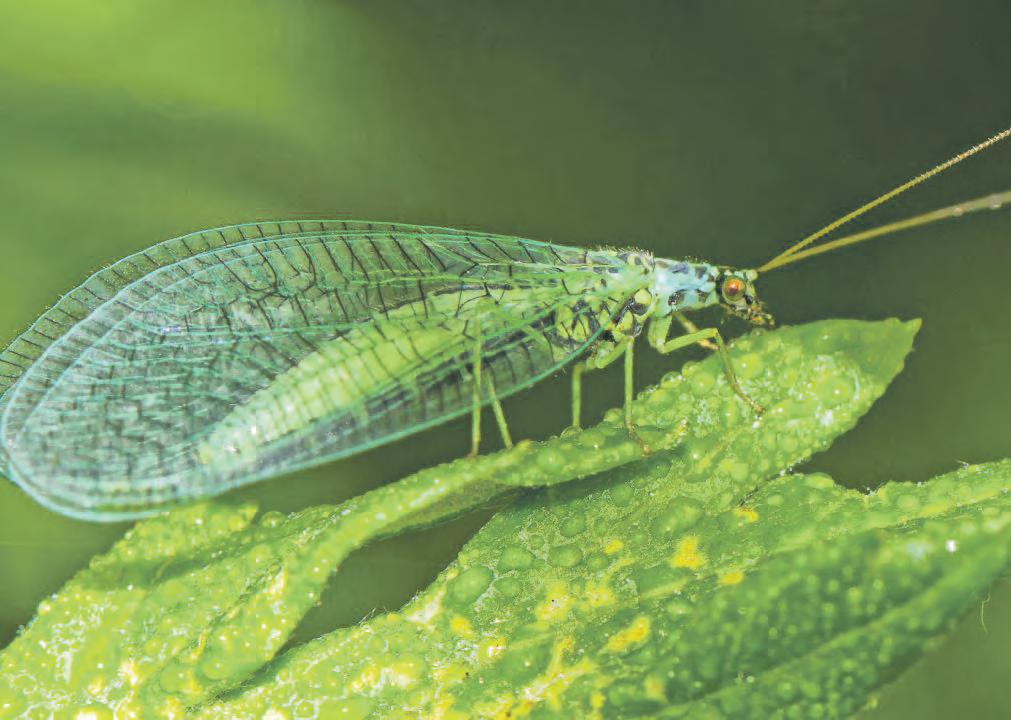
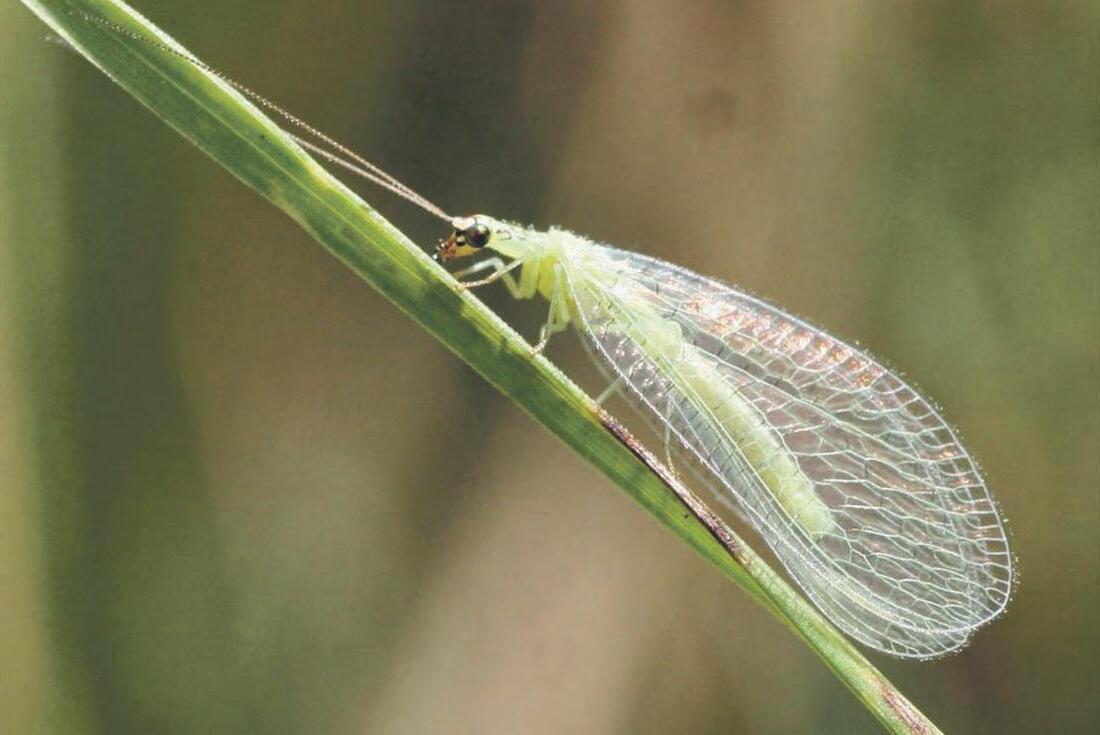
It’s time to admire the exquisite wings and appetite for aphids of one of our few hibernating insects.
We are all well versed in seeing insects of all shapes, sizes and colours in an English garden but there are amongst them some surprising heroes. Because of its appetite for plant pests, the green lacewing is a delightful companion for gardeners.
In the UK we have about 40 species of lacewing but only one of them hibernates, the common green lacewing (Chrysoperla carnea). The body of this creature is a little prehistoric in appearance, it has large eyes and long antennae which make it look rather unattractive. However it does have the most wonderful set of wings imaginable. These large wings are translucent and intricately veined, reflecting light at slightly different angles just as you might expect to see from leaded windows.
To gardeners the green lacewing is a good-guy because it is a potent predator of aphids and so should be welcomed into our gardens. The more lacewings we can support through the winter in our gardens, the bigger head start they will have when it comes to tackling aphids in the spring and summer. To help them, we need to think about where they like to hibernate.
Adults can be seen in gardens, flower beds, parks, meadows, farms, and fields at dusk, when they are all at their peak.
Larvae eat almost any insect they encounter, and aphids (smaller flying insects that can harm plants) are their favourite.
Adult flying adults are born in the summer, when a few tiny larva are laid in the spring.
They can be found in the spring and summer and have a significant impact on insect control.
This slightly odd-looking insect is harmless.
Even in mild winters life for a small insect in Britain is extremely difficult. For this reason most insects survive the winter as eggs, caterpillars or chrysalises which lie dormant in tree holes, amongst leaf litter or even underground. There are a few, though, that over-winter as adults, hibernating through the worst of the weather and waking when temperatures rise.
Generally lacewings hibernate amongst leaf litter so if you tidy leaf litter away from paths consider leaving it in a corner of the garden until the spring, maybe use it as a mulch but don’t pack it tightly into a compost bin from which the insects will never be able to emerge.
It is possible to buy, or make, insect hibernating ‘houses’ and some of these are specially made for lacewings but, such structures are no substitute for wildlife-friendly gardening. If you do have a lacewing house, it is important to remember to clean it out in early autumn, earwigs often take up residence in summer and will kill any lacewings as they arrive.
Most gardeners would agree the two big water related issues which never seem to go away are getting everything in place to properly collect rainwater and when it comes to having a pond in your garden – keeping the water clean.
On the first point it seems we all have still a lot to do. Only three out of ten gardens have proper and efficient rainwater collection systems. A recent survey said that while many more had water butts in place the collection of the water was poor. Others knew what needed to be done but didn’t see it as a priority. Rainwater harvesting is also a smart way to reduce your water bill as it can be used for several purposes. The upfront cost of a rainwater harvesting system depends on the volume of water you choose to collect and its planned use. The simplest form of rainwater harvesting system includes installing a water butt and linking it to your gutter system with tubing or external downspouts. The rain is collected in the water butt and used to water gardens, lawns and plants. The figures are beyond question. Installing water butts can save up to 5,000 litres of water a year. And your plants will thank you for rainwater rather than treated tap water.
This is a common question amongst pond owners and it is a multifaceted answer…
Green water comes from an accumulation of single celled algae. These tiny cells are too small to be trapped by mechanical medias (like sponges). Trees, bushes, and other plants will drop leaves and debris into the pond. Fish and wildlife that may visit your pond will create waste. All this matter comes together to create sludge and murky water.
The best way to combat this is to install a pond filter. There are lots of different filters available and working out the right one for your pond will come down to several factors. How big is your pond? Do you have a couple of fish or loads of them? Where would you like the filter to be?

The main rule of filtration to remember is that it’s always better to over filter; after all your water can’t be too clean!
OASE has a filter to suit any pond. From small in-pond filters to pressure filters, to box filters to large drum filters that can filter koi ponds up to 100,000 litres. What’s more, if you use a complete OASE solution with pump, filter, and UV you will be covered by their Green Water Guarantee.
Visit your local OASE retailer for help on which filter, pump and UV will suit your specific pond system. www.oase.com
It’s amazing just how much rainwater you can collect from a greenhouse or shed roof but it can be a challenge to find a way to connect their small diameter guttering to your water butts.


Water butt specialists Rainwater Terrace say ‘where there’s a will, there’s a way’so have developed many options that do just that. Every garden is different so any problems you have, there’s a human at the end of a phone to help.
Their Rainwater Terrace Water Butt system is versatile and can be connected sideways as well as upwards to maximise your supply of nice clean rainwater. The ability to keep it low can be a real benefit where your gutters are low, there are windows in the way, or you want the kids to have somewhere to potter at their level. There are kits for schools too.
Find out more at www.rainwater-terrace.com or phone 01937 845176


Good filtration is the key to any healthy looking pond. With OASE’s technical knowledge anyone can achieve crystal clear pond water this summer. One of the easiest ways to achieve this is with the new OASE FiltoClear pressurised filters.
Not only is a FiltoClear easy to install, it’s even simpler to clean. Just turn the nozzle to “Clean” and pump the handle at the top of the head unit until the water runs clear, that’s it! On top of this, the unit also includes a UV clarifier that gets rid of floating algae and bacteria.
The FiltoClear is also available as a set with an OASE pump, making it even easier to get clear pond water today. It is the complete pond filter package for your garden.
The FiltoClear range is developed to be out of sight and out of mind as all working parts are integrated in the cover (the photo to the left depicts a FiltoClear being buried). We also offer a clear water guarantee when an OASE pump, filter and UV are all used together.
Find a new OASE FiltoClear from your local retailer today and enjoy clear pond water this summer.
This is often one of the hottest months of the year and a great time to sit out and enjoy your garden. Keep plants looking good by regularly dead-heading, and you’ll enjoy a longer display of blooms. You will need to keep watering and giving flowers and vegetables extra care to keep them growing. Here are the jobs you need to keep on top of.

Be sure to keep all new plantings well-watered: shrubs and trees can need much more water than you’d think. A thorough dousing twice a week is better than a little each day. Keep feeding and dead-heading bedding plants to keep the flowers coming. If they start to look tired and straggly, cutting them back, followed by a generous feed, will usually encourage them to try harder. In hot, dry weather, set the mower a bit higher, to keep the lawn looking green. But if it does turn a little brown, don’t panic – it will soon recover once the rain arrives.
Most flowers lose their attraction as they fade, spoiling the overall appearance of beds, borders and containers, and are best removed. However, there are other reasons: Deadheading keeps plants looking attractive and encourages re-flowering and directs energy into stronger growth and more flowers. Once the flowers are pollinated; seed heads, pods or capsules form at the expense of further growth and flower development.
It can prevent plants with numerous petals, such as peonies, some camellias and many roses, scattering debris widely. Remove the spent flowers as soon as they look scruffy. In practice, gardeners usually must remove them as soon as they can and, thankfully, a few day’s delay won’t make a difference. Some obliging plants do not need deadheading. Typically fuchsias, bedding lobelia and salvias either don’t set much seed or neatly deadhead themselves.
Do not remove the faded flowers on plants that produce seed loved by birds, including rudbeckia, cornflower and sunflower. There is no need to deadhead rose cultivars that bear hips or other plants that bear berries in the autumn.
There are lots of veg that can be sown now to fill gaps as earlier crops are cleared and to give fresh veg into the autumn and winter.
• Sow kohlrabi, lettuce, leaf beet, chard, endive, chicory, Florence fennel, chervil and coriander.
• Finish sowing beetroot and savoy cabbage in the first week of July.
• After mid-July, sow land cress, Chinese cabbage and spinach.
• From the end of July to mid-August, sow mustards, pak choi and salad rocket.
5

Take cuttings from shrubs and alpines

July is a good time to take cuttings from shrubs and alpines. Take the cuttings from non-flowering shoots and place them around the edges of small pots that are filled with peat and perlite. Water the cuttings in and keep them warm but out of direct sunlight.


Watering is one of the most important jobs when growing plants in containers. Due to their restricted root area, container plants rely on us to provide the water they need, as well as take steps to make sure they aren’t getting too wet.
To grow well, plants need a wide range of nutrients in various amounts, depending on the individual plant and its stage of growth. The three key plant nutrients usually derived from soil are nitrogen, phosphorus and potassium, while carbon, oxygen and hydrogen are absorbed from the air. Other vital soil nutrients include magnesium, calcium and sulphur. Gardeners can add nutrients by applying fertilisers (either artificial or naturally derived) to boost plant growth and improve flowering and fruiting.
Plant roots eventually fill containers and this often reduces growth. Eventually, container plants need to be moved to a bigger pot or the compost refreshed in the same pot, as composts lose their structure over time. Shrubs and trees that stay in a pot for years are especially vulnerable unless re-potted.
6 4
It is a good idea to feed your roses in midsummer as this will help them produce a second flush of flowers. For any roses that have finished their first flush of flowers, trim them back before feeding. Roses need pruning because this encourages them to produce new shoots, since cutting back a branch helps the rose to produce a growth hormone. When cutting them, make a cut five mm above an existing bud with gardening shears. Ensure the cut is angled away from the plant as this prevents rainwater from collecting and causing disease as a result.

Bearded irises will have finished flowering and this is the best time to divide clumps. Dig up the whole thing and you will find that it will separate into rhizomes (the lumpy bits that look like root ginger). Discard any parts that are dead or wasting away and replant the rest. Make sure the rhizome is on the surface of the soil as they need to be baked by the sun to flower. It helps if you cut the leaves in half to stop the wind rocking them and so uprooting them.
Ponds and other water features also need some care in July to keep them healthy and looking good.
• Look out for any yellowing leaves. If they are left on water lilies and other water plants, remove them promptly. Allowing them to fall off and rot in the water will decrease water quality.
• Remove blanket weed. This will let oxygen into your pond. Use a net or rake and remember to give aquatic life a chance to get back to the water by piling the weed next to the pond for a day.

• Top up water levels. Water can evaporate rapidly from water features and ponds in the height of summer, so top them up if the water level drops significantly. Rainwater from a water butt is best – chemicals in tap water can affect the nutrient balance in the pond.
• Hosepipe ban. If your area is under a hosepipe ban, you can still use it to top up your pond if you have fish.
• Clear filters. Remember to clean any filters and pumps.
Remember that producing fruits makes plants thirsty, currants are perhaps the best example of this so water at the roots to avoid encouraging damp related diseases. Strawberries are prone to these so don’t wet their leaves and avoid overwatering which can also cause trouble such as botrytis.
Mulch around fruit trees and bushes to conserve moisture. Apply a two-inch layer of mulch after it’s rained when the ground is damp, making sure not to let the mulch touch the trunks or stems. Make sure the ground is first clear of grass and weeds. Fruit in containers will need a thoroughly good soaking when the surface of the soil feels dry. Water until water drains out from the bottom. Don’t water again until the surface has dried out. In dry weather water every fortnight or sooner if the soil is dry, a good spade’s depth down.

Pick off the larvae of the scarlet lily beetle, Lilioceris lilii, which devastates all members of the lily family including fritillaries. The larvae are brown with black heads, but are usually hidden by their slimy black excrement, so do wear gloves.
With no natural predator, these Eurasian beetles (a colony was first discovered in the UK in a garden in Chobham in Surrey in 1939) have now spread across the country. The beetles overwinter in the soil, so if you grow lilies in pots, repot into fresh compost in early spring, or lift lilies in the ground, shake off the soil and replant in a new spot.
Pinch out the side shoots of tomatoes. These are the small leaves that form at the base of the main leaves where they meet the main stem. Feed regularly every ten to 14 days and make sure they do not dry out or developing fruits will split.

These hugely popular shade-loving plants are primarily grown for their beautiful foliage. There’s a vast range to choose from, with leaves in all shades of green, as well as dusky blues and acid yellows, sometimes variegated or flashed with cream or gold, ruffled, smooth or distinctively ribbed. Many also produce small trumpet-shaped mauve or white flowers in summer. Hostas are notoriously irresistible to slugs and snails, but are also much loved by gardeners, who often amass large collections.
Where do hostas grow best?
All hostas give their best in moist soil in partial shade, certainly away from bright sunshine whether in the ground or a container. In general, though, yellow-leaved cultivars prefer some sun, along with a few hostas that are tolerant of sunny conditions.
Do hostas grow better in pots or the ground?
Hosta grows better in containers as opposed to garden beds because they do not have competition from weeds which can be hard to remove without harming the roots of the plants. Container hostas are easier to grow in shady areas as well. You can move them around if the sunlight is too strong.

Will hostas return year after year?
Hostas are reliable long-lived perennials. When planted in the right spot and cared for properly, they will come back year after year, often getting bigger and better with each season – something which is a huge attraction to gardeners who collect different varieties.
What month is best to plant hostas?
You can plant hostas all year round, but spring and autumn are preferable. It’s best to avoid planting in mid-summer, when temperatures are high and the water table is low, as this can prevent the plant from establishing well. Mid-winter is also a bad time to plant hostas, as the ground is cold and often frozen.

Do hostas have a lifespan?
Hostas require little care and will live to be 30 or more years if properly cared for. While most known for thriving in the shade garden, the reality is more nuanced. The ideal situation is dappled shade.
Do hostas multiply on their own?
Hostas can spread, either through underground runners or seeds. Rhizomatous Hostas that spread underneath the soil are the worst offenders. These varieties will spread almost indefinitely. NonRhizomatous varieties will grow in clumps that reach a mature width.
What should I do with hostas when they get too big?
Using a spade and/or garden fork, dig six to eight inches outside of the crown of the plant. Depending on the hosta variety, the root system may extend eight to 18 inches deep. Starting from one side and working your way around, dig beneath the roots. then ease the clump out of the ground.
Do hostas lose their leaves in winter?
By winter hostas will have entered their dormancy stage and the leaves will have completely died back. You don’t need to do anything with your hostas over winter, they are completely hardy and do not need bringing inside or frost protection.
How deep should you plant hostas?
Perhaps deeper than many think. Dig a hole, at least 12 inches deep and almost twice the size of the mature plant. Mix in a good layer layer of organic matter.
How do I protect my hostas from slugs?
Slugs and snails love hiding in crevices and behind stones. Take their hiding places away. Try putting your hostas in pots, then protect the pots with Vaseline or WD40 which make them greasy and prevent slugs and snails from climbing them.
Cornwall has an earlier spring than many other parts of the country, but the beauty of its gardens continue through the summer. Here are some gardens that will open for the National Garden Scheme during July, so if you’re enjoying a holiday in Cornwall or are lucky enough to live near the county, take your pick. Do check before starting out on a journey as circumstances can force cancellations of private garden openings. www.ngs.org.uk
Cardinham, Bodmin PL30 4BN


Three gardens open in this rural south west side of Bodmin Moor for the NGS on Sunday 9th July, 11am-5pm.
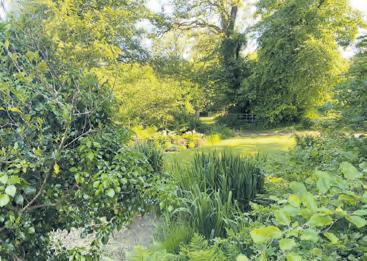

The Beeches, a small easymaintenance garden with roses and climbers, shrubs, and colourful containers, Treslea is a wildlife haven, a cottage garden with borders, roses and an orchard/vegetable plot, and Pinsla, another cottage garden with unusual planting, intricate paths, garden art and a stone circle. Homemade teas at Treslea. Dogs allowed at Pinsla.
Winsor Lane, Kelly Bray, Callington PL17 8HD
More than 100 named roses, several hydrangea varieties and perfumed plants in this one-acre garden that also has a waterfall, pond, lawns, shrubs and trees, pergolas, fruit, cut flowers and vegetable garden. It opens for the NGS on Saturday 15th and Sunday 16th July, 11am-4pm (also 20th August and 9th September). Admission £5, children free.


OUR KEY TO FACILITIES ON OFFER AT THE GARDENS:
Zelah, Truro TR4 9JD
A two-acre garden transformed over 40 years from bleak windswept fields to a haven of trees, shrubs, perennials, wildflowers and a cut flower growing area, new herbaceous border and hydrangea walk. Opens for the NGS on Saturday 15th and Sunday 16th July, 2pm-5pm each day, admission £5, children free.
Wharf Road, Lelant, St Ives, TR26 3DU
A tropical feel to this garden that opens for the NGS on Saturday 22nd July, 2pm-6pm, with a swimming pond surrounded by lush vegetation, an Italianate sunken garden, numerous young trees and masses of Echium pininana

Chacewater, Cornwall
TR4 80B
There’s a mass of summer colour in this one-acre garden, with the national collection of Clematis viticella at its peak in July when it opens for the NGS on Saturday 1st and Sunday 2nd July, 1pm-5pm. Other climbing plants for foliage and scent, Victorian conservatory and greenhouses also full of interesting plants, and there are two ponds. Admission £5, children free.
Menheniot village, PL14 3RZ
A group of eight gardens in the attractive old mining village, with its Holy Well a short distance from the historic parish church, are opening for the NGS on Sunday 23rd July, 2pm-5.30pm, with cottage gardens, community spaces, a wide range of plants and a section on rewilding. All within reasonable walking distance from the sports pavilion, light refreshments at the Old School adjacent to the village green. Combined admission £5, children free.
Picnics welcome
Lamorna, TR19 6XH
Spectacular threeacre cliffside garden overlooking Lamorna Cove, with many southern hemisphere shrubs and exotics, woodland area with tree ferns set against granite outcrops, the garden terraced with steep steps and paths –and plenty of benches to admire the views.
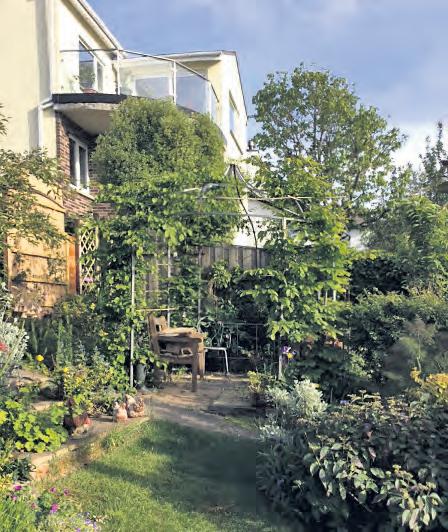


Open for the NGS on Saturday 22nd and Sunday 23rd July, 2pm5pm, admission £5, children free.



Sennen, Penzance
TR19 7AH
Once a concrete farmyard, now the most westerly walled garden in England showing that roses thrive in Cornwall. Visitors can walk the circular coast path from Land’s End to Nanjizal and back across the fields to Trevilley, this eccentric, romantic garden with its elaborate cobbling, container and shade gardens, large subtropical mowhay garden and studios of owners novelist Patrick Gale and sculptor/farmer Aidan Hicks. Open for the NGS on Saturday 8th July, 1pm-5pm, admission £5, children free.
Dunheved Road, Launceston
PL15 9JE
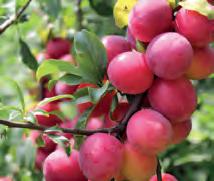
PJust £20 for a respected, knowledgeable and inspirational gardening magazine

The subscription costs just £20 and guarantees a 10 times a year magazine packed with information , gardening advice, local events.
You can select from one of our five editions of the magazine which is relevant to where you live.
Just fill in the form below and include your cheque for £20.
I would like to subscribe to Country Gardener for the next ten issues for £20:
This is a subscription just for me *
This is a gift (send next available issue) *
Please choose your region by ticking the box:
Cotswolds * Devon * Dorset * Somerset * Hampshire *
Your details:
A small town garden packed with plants and interest with tropical banana trees, gingers and senecio, but also herbaceous borders, rockery, stream and water features, roof garden, courtyard with bridge, a Japaneseinspired tea house; a fig tree and a Pawlonia give a secluded seating area. Open for the NGS Sunday 30th July, 1pm5pm, admission £5, children free. www.countrygardener.co.uk
Tel No Details of gift recipient:
Remember to tell us which one of the five editions you would like to receive.
ACCOMMODATION
FRUIT/VEG CAGES
Secluded cosy cabins & lodges in wooded valley running down to Wembury Bay & SW Coastal Path

Plymouth, Dartmoor & lovely South Devon Villages & Towns in easy reach. Pets
Welcome. Forest School. Tel: 01752 862382 www.churchwoodvalley.com
Carmarthen Bay South Wales
Seafront chalet situated on estuary.

Sleeps up to 6. Seaview. Well Behaved Dogs Welcome Free of Charge. Free WIFI. Open from 1st March - 31st Dec. For Brochure
Tel: 01269 862191
GLORIOUS NORTH DEVON. Only 9 cosy caravans on peaceful farm. Wonderful walks in woods & meadows. Easy reach sea, moors & lovely days out. £125-395pw. Discount couples. Nice pets welcome. 01769 540366 www.snapdown.co.uk
BOSWORLAS NEAR SENNEN/ST JUST, CORNWALL. Cosy Cottage, rural views, Sleeps 2-4 01736 788709 www.bosworlas.co.uk
ACCOMMODATION HOLIDAY COTTAGES

SANDWAYS
HOLIDAY COTTAGE SIDMOUTH, DEVON
A quiet holiday bungalow near Sidmouth, overlooking the Donkey Sanctuary. Ideal for walkers and nature lovers. Available to rent from April to October. Sleeps 4.


jandtmercer@gmail.com www.sandwaysholidaycottage.co.uk
07842 514296
WYE VALLEY/FOREST OF DEAN. Fully equipped single-storey cottage with two en-suite bedrooms. Wi-fi.Recently awarded Visit England 4-star GOLD. Rural retreat, shops/pubs one mile. Enquiries welcome. Tel: 01594 833259 www.cowshedcottage.co.uk
Views!
4* Delightful cosy cabin for 2, nestling between Wye and Usk Valleys. Shirenewton village & pubs close by. Wonderful walks, splendid castles, bustling market towns. Perfect for all seasons!
Tel: 01291 641826
Email: lynne@bryncosyn.co.uk www.bryncosyn.co.uk
ACCOMMODATION WITH BEAUTIFUL GARDENS
Welcome to Redcroft
Hampshire Country House Fabulous Gardens Comfortable Bedrooms 5

Mins walk from Hamble River Within 15 mins Southampton & Portsmouth Call 07768997979
Gloucestershire Quality
Bungalow B&B
GARDEN BUILDINGS

Penrice Castle Gower
16 holiday cottages on an 18th century Estate on the Gower Peninsula with beautiful Grade I listed historic park and gardens.

Tel: 01792 391212
Ensuites, rural, large garden, paddocks, sheep and fruit. Ideal Cotswolds, Malvern’s, Forest of Dean, cycle storage, ample parking, Wi-Fi £40 p.p.p.n. Tel: 01452 840224 sheila.barnfield1960@gmail.com
CARDS, PRINTS & GIFTS
Near Stratford-upon-Avon
Lovely self-catering cottage in peaceful location: large garden. Sleeps 2. Perfect for famous gardens, NT properties & Cotswolds.
Tel: 01789 740360
www.romanacres.com
NORTH DEVON NEAR CLOVELLY. 3 delightful cottages situated in 12 acres of idyllic countryside. Sleeps 2-4. 1 Wheelchair friendly. Brochure: 01237 431324 www.foxwoodlodge.co.uk foxwoodlodge@outlook.com
A range of over 200 greetings cards and prints from the flower paintings of ANNE COTTERILL

We sell to both individuals and trade. No order too small. Contact us for your free catalogue.
Mill House Fine Art Publishing, Bellflower Gallery, Market Place, Colyton, Devon EX24 6JS Tel. 01297 553100 info@millhousefineart.com www.millhousefineart.com

ECOLOGICAL LANDSCAPING CONSULTANCY & DESIGN
Specialists in Nature Recovery & Habitat Enhancement


Providing Nature-Based Solutions for: Ecological Landscape Design, Wildlife Ponds, Lakes, Wetlands, Nature Landscaping, Conservation Arboriculture.
Looking
Tel:
GARDEN PLANTS/ACCESSORIES

jonne@jonne.co.uk
07770 720 373
Artist blacksmith based near Axminster designing and manufacturing garden plant supports, structures, garden art and fine art bronzes. Commissions welcomed.

GARDEN SERVICES
HERE FROM
JUST
HERE FROM JUST £2 PER WORD
Consultancy & Design. Management & Construction. Tel: 01392 240 877
Restoration@LostHabitat.uk LostHabitat.uk
POLYTUNNELS


Call: 0800 103 2800 www.wmjames.co.uk Fruit Cages & Netting made in the UK Get 10% Off Online with Voucher Code: CG2023 POLYTUNNELS FROM £499 AVAILABLE TO VIEW BY APPOINTMENT 01363 84948 info@ferrymanpolytunnels.co.uk www.ferrymanpolytunnels.co.uk Country Gardener 36

Our August issue will include our hugely popular annual guide to speakers available to talk at garden clubs and associations.
It’s something for clubs and speakers to look out for.
Gardening clubs and associations throughout the country are getting back to normal after three years of disruption caused by Covid.
It has been a tough time for many clubs, initially hit by being unable to hold meetings and then finding they needed almost to start again in terms of members and get togethers. So clubs are now starting to out together details of their meetings for the autumn and right through into 2024.
It means a huge demand for gardening speakers, demonstrators and a great opportunity for those experts and enthusiasts who put themselves in front of clubs. Country Gardener magazine has a long standing dialogue with hundreds of clubs throughout Devon, Dorset, Somerset, Hampshire and the Cotswolds and in our August issue will be again offering our readers a comprehensive guide to club speakers with details of subject matter, speakers CV, travelling distance, availability and costs.
If you would like to put your speakers skills in front of hundreds of gardening clubs then please contact us before 10th July.
Devon: cath.pettyfer@countrygardener.co.uk



Cotswolds & Dorset: corina@countrygardener.co.uk
Somerset, Hampshire and anywhere else ava@countrygardener.co.uk




Our popular gardening themed crossword is compiled by Saranda which over the past year has become enormously popular with readers. The winning entry to be drawn by us will receive £100 of RHS gift tokens. Completed entries should be sent to Mount House, Halse, Taunton, Somerset TA4 3AD. Closing date is Friday 21st July. The winner of our June issue crossword was Mrs Seaton from Bristol.
ACROSS
1. Campanula rotundifolia or Scottish bluebell (8)
5. Beautiful plant perhaps named after Gruyere? (5,6)
12. An ancient underground passage where people were buried (8)
13. Heritage railway in Sussex with floral connection? (8,4)
15. Love apple scourge? (6,6)
16. Perennial plant of the daisy family with aromatic leaves (8)
17. To unload from a traditional farm vehicle (6)

18. A very short time (10)
22. Swindles more than one Bromus tectorum! (6)
23. Relating to trees (8)
24. Indigo dye found in Caribbean shrub (4)
28. Family of grasslike plants known as sedges (10)
29. Lines of descent used by aeroplanes to land (5,5)

31. Unit of area used in English-speaking countries (4)
32. A marine plant that grows in coastal waters (8)
33. Surname of Wurzels’ leader? (6)
36. Flower named after Christian festival on 29th September (10)
37. Previous name of Ningbo, ancient Chinese city on the Silk Road (6)
40. Receptacle used by sailors to hold useful things (5,3)
41. Cambrian flowers that love damp, shady habitats (5,7)
43. A diplomat acceptable to the government to which he is sent (7,5)

44. Collective term for outer parts of a flower (8)
45. Common water lily found in North America (11)

46. King of Ithaca and hero of epic poem by Homer (8)
DOWN
1. Goddess of Greek mythology associated with witchcraft (6)
2. Genus of flowering bushes commonly called broom (6)
3. Reversion to a simpler way of life including gardening? (4-2-6)
4. Phaseolus lunatus, a legume grown for its edible seeds (4,4)
6. Asian allium that forms clusters of slender bulbs (5,5)
7. A plant’s stalk (4)
8. Gastronomic creations attributed to restauranteur Cardini (6,6)
9. Marine plant of genus Zostera similar to 32 (8)
10. Common name of Urtica dioica, a plant of which to be careful (8,6)
11. The wild or sweet cherry (4)
14. A favourite English fruit named after a long lived queen (8,4)
19. The state of being not wanted or required (12)
20. Commonly called wattles, this small shrub belongs to the pea family (6)
21. Confection made with essence of a garden plant (10,4)
25. A gentle sheen or period of five years (6)
26. Legendary Persian queen and oriental trumpet hybrid (12)
27. Common name of flowering plants, Papaver Somniferum (5,7)
30. Shaped like a certain phase of the moon (10)
34. Oldenlandia umbellata, a medicinal plant (4,4)
35. Also known as hardheads, this weed belongs to genus Centaurea (8)
38. Botanically, having long and soft hairs (6)
39. Willow shoots (6)
40. Common name of marijuana (4)
42. I eliminate flower of a certain genus? (4)
You gingerly straighten up, give the old back a rub, pat down the last of the soil and walk away.
Tree planted – job done.
No.
Tree planted – job only just begun!
We are entering a period of dry, breezy weather. The trees you planted last winter are at serious risk of not making it through to the next winter.
Why are they at such risk?
Mostly it is about water and the trees’ ability to capture it. Not many trees are tapped into permanent sources of ground water, so their main source of moisture is intercepted rainfall. In order to catch as much rainfall as they can, young trees grow lateral roots quickly.
A young tree grown in situ from seed with a trunk diameter of two inches (50mm) is likely to have a root system with a radius of six feet three inches (nearly two metres) giving a root system area of approximately 12.5m², that’s 134 sq ft.
If you think of that as a giant bowl, it would catch a lot of rainwater.
Now think back to that tree planting pit you dug. If it was one square metre or nine sq ft, you are a National Hero! Most of them are less than that. You were very careful with the roots. If the tree was container grown you gently teased the roots out sideways, if it was bareroot, you didn’t let them dry out and you didn’t cram them into the hole – I believe you.
But compare the size of the bowl your tree has to catch water in with the one available to the self-seeded ‘wild’ tree. It doesn’t matter how well you looked after the roots of your planted tree, there are simply not enough
of them to catch enough water to sustain your tree through a dry spell.
The ‘wild’ tree is probably growing in a woodland clearing, with a friable soil covered in old leaf mould. Roots freely penetrate this soil and moisture percolates through readily. Now look at your tree, growing in a little circular bed cut into the lawn.
Grass kills more trees than Plymouth Council. It has first dibs at intercepting the rainfall and it creates a root mat five times denser than that found in woodland. Your tree really has to work to spread its roots outside the tree pit.
So, what do you need to do?
Well, I don’t expect you to rewild your garden by introducing wild boar and timber wolves. Once the tree is established it will cope with the grass, and in the end, once it is mature, the tree’s shade will hopefully kill the grass off.
Revenge is a dish best served cold.
All you need to do is keep the tree watered. If you also mulch the extent of the tree pit with composted woodchip, or even pea shingle, to keep competing weeds down, even better. How much water? Your young tree needs about ten gallons a week whenever there is no significant rain, but please don’t do it all on Tuesday, spread it over the week otherwise too much of it runs off to be nabbed by the grass.
The healthier you keep your tree with weed control

Time Off
Kate Lewis timeoff@countrygardener.co.uk Advertising
Cath Pettyfer - Devon cath.pettyfer@countrygardener.co.uk
Tel: 01837 82660
and watering the faster it becomes independent in the landscape and able to fend for itself. It will take it a few years to catch up with its wild sister in the woods, but the frequency of watering can be reduced as the tree becomes stronger.
Use water from your rainwater butts.

Your tree does not have teeth and therefore no use for fluoride.
www.treeadvice.info
Design & Production Aidan Gill aidan@countrygardener.co.uk
Distribution & Stockists
Pat Eade distribution@countrygardener.co.uk
Editorial Publisher & Editor: Alan Lewis alan@countrygardener.co.uk
Tel: 01823 431767
Corina Reay - Cotswolds & Dorset corina@countrygardener.co.uk Tel: 01823 410098
Classifieds classified@countrygardener.co.uk
Gemma Stringer gemma@countrygardener.co.uk
Accounts and subscriptions
Heather Rose heather@countrygardener.co.uk Magazines
Mark Hindsley looks at why that newly planted tree might not make it through to next winter.Mark Hinsley, of Mark Hinsley Arboricultural Consultants Ltd, offering tree consultancy services.








AS SUMMER APPROACHES, IT IS THE PERFECT TIME TO WANDER AROUND OUR INSPIRATIONAL DISPLAYS.

Get ideas for your own gardens from our plant combinations. We have trees, shrubs, climbers, cottage garden plants, herbs, plants for shade... and so much more.



Perfect Perennials - Gaura, Coreopsis, Verbena, Dahlia, Heucheras... all flower non-stop until late Autumn
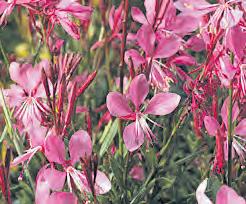
Plants for Butterflies, Bees and Wildlife - Buddleja, Verbena, Agastache, Salvia... “Collectors Corner” of
and Hard to Find Plants
